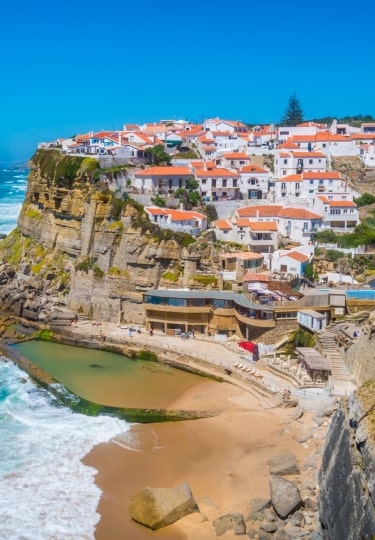Author’s Note: I’ve been lucky enough to call one of Portugal’s best beach towns home for years, but that hasn’t stopped me from challenging myself to visit every coastal town in the country.
Portugal’s 1,155 miles of scenic shoreline, all craggy cliffs, golden beaches, and wave-carved caves, have earned the country enviable fame. But it’s not just the bays and barrier islands that make this coastline glimmer. The best beach towns in Portugal are equally enchanting.
From chic coastal retreats near Lisbon to wildlife-watching hotspots on the county’s remote islands, Portugal’s coastal towns are as diverse as the country’s beaches.
Whether you want to learn about the nation’s nautical history, sample the freshest seafood, seek out surf-friendly swells or glimpse medieval fortifications, these are some of the best beach towns in Portugal to visit.
Câmara de Lobos
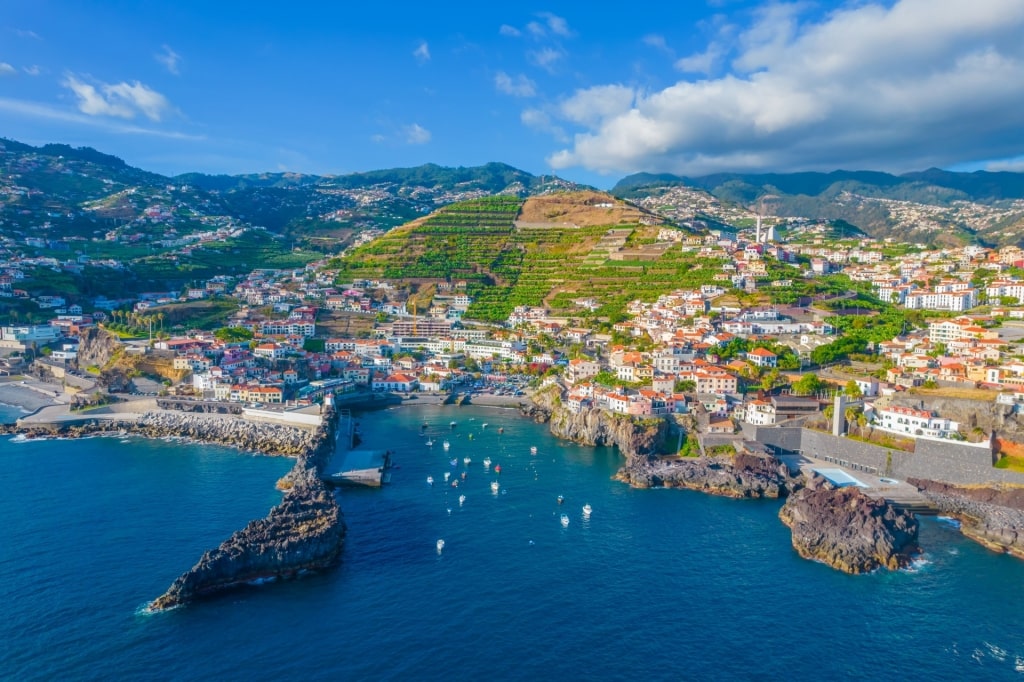
Câmara de Lobos
Câmara de Lobos—a harbor-hugging, cliff-climbing coastal town on the remote island of Madeira—has tantalized travelers for centuries. Not only is the setting utterly gorgeous, but the laid-back town retains something of a bygone aura.
Hand-painted fishing boats bob in the idyllic bay, their captains usually playing cards on nearby tables. Vineyards and banana plantations cascade down the verdant slopes, and the photogenic streets are adorned with upcycled art.
Long a muse for artists, this indelible panorama has inspired the likes of Winston Churchill, the fabled former Prime Minister of the United Kingdom, whose painting vacation here has been memorialized by a statue.
Whether you’re looking for a romantic meal, teen-entertaining street art, or to kayak below dramatic coastal cliffs, Câmara de Lobos is a real crowd pleaser.

Câmara de Lobos
Along the shorefront, Praia do Vigário is one of the best beaches in Madeira, providing bathing opportunities in the shadow of Cabo Girão, a soaring sea cliff. Nearby, an open-air swimming pool presents a more tranquil dip.
Post-swim, refresh with one of the island’s signature drinks. Poncha, a sweet cocktail crafted from honey, sugar, juice and Madeira’s sugarcane rum, was invented in Câmara de Lobos.
Once the preferred beverage of local fishermen, it has since become a popular drink across the island. For a more refined quencher, visit Henriques & Henriques, a respected winery offering tastings of fortified Madeira wine.
Cascais
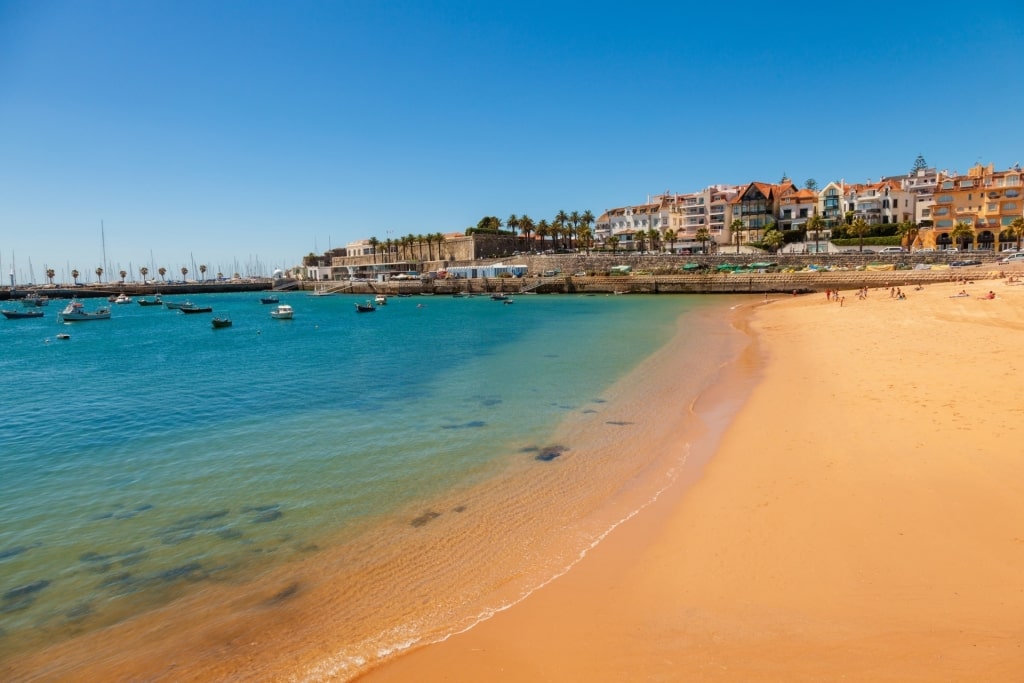
Cascais
Once you’ve ridden Lisbon’s iconic trams and explored Belem’s cultural highlights, take the short hop by train to chic Cascais.
Long adored by well-heeled holidaymakers, this coastal escape was once the preferred summer retreat for royals seeking respite from the heat of the country’s capital.
Nowadays, Cascais is considered one of the best beach towns in Portugal. Here you’ll find a fetching historic center embellished with calçadas (decorative pavements), heritage buildings, and a plethora of straight-from-the-boat seafood restaurants and inviting beaches that Portugal is famous for.
Stews made from mexilhões, or mussels, and freshly grilled sea bass are particularly typical of Cascais’ culinary scene. However, due to the town’s regal links and hunting history, rabbit and poultry still feature on many menus.
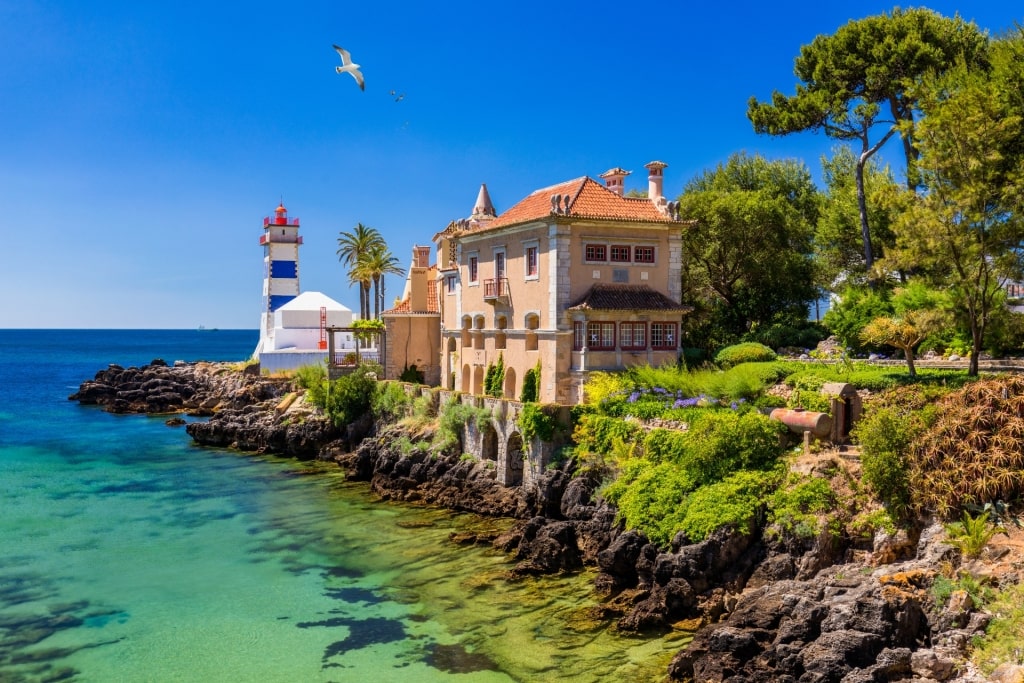
Casa de Santa Maria, Cascais
Stately homes, forts and former palaces, such as Casa de Santa Maria and the Citadel of Cascais, pay homage to the town’s former status. Many of these have now been converted into cultural institutions and museums.
The elegant Museu Condes de Castro Guimarães will delight history enthusiasts with its tiled-hemmed Manueline arches and 19th-century decor and furniture.
Along the waterfront, the promenade snakes from Cascais to Praia da Duquesa and the oceanfront natural pool of Piscina Oceânica Alberto Romano. Slightly sheltered, Cascais’ southern beaches are always a popular day trip from Lisbon for locals keen to sunbathe or swim.
If you’re a surfer or simply looking for more untouched sands, detour slightly out of the town to dune-backed Praia do Guincho, where kitesurfers and swell-seekers embrace the Atlantic winds.
Costa da Caparica
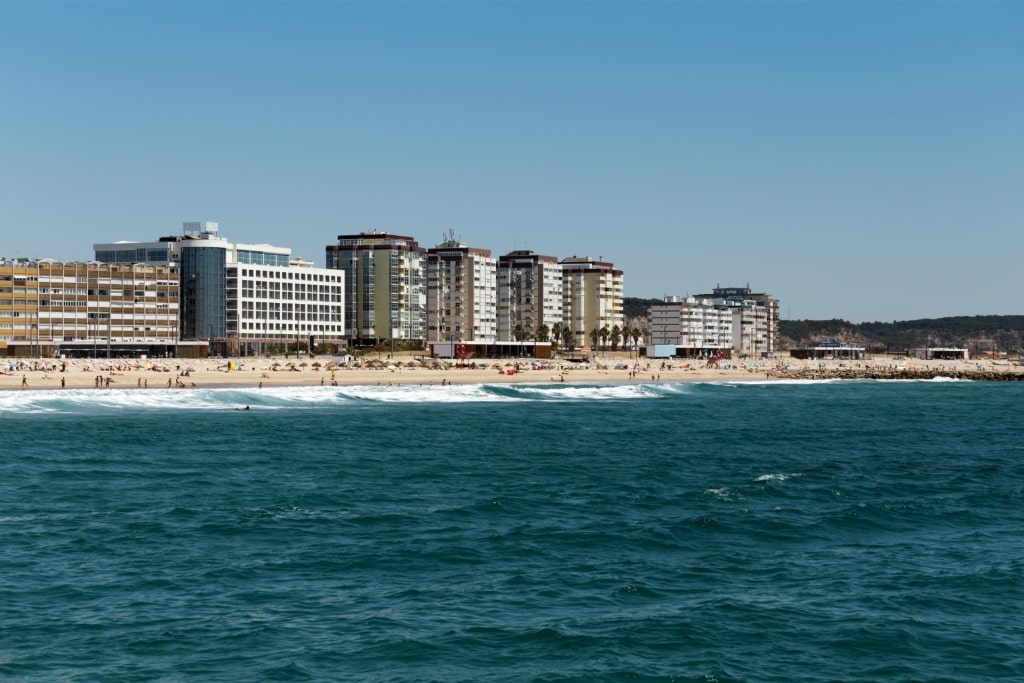
Costa da Caparica
When the sun sizzles in Lisbon, Costa da Caparica calls. As one of the closest coastal escapes from the capital, situated across the River Tejo, this Portuguese beach town is a local go-to.
With a laid-back yet cosmopolitan resort-like vibe, the area boasts a mix of trendy brunch spots and quality coffee roasters alongside more traditional seafood restaurants.
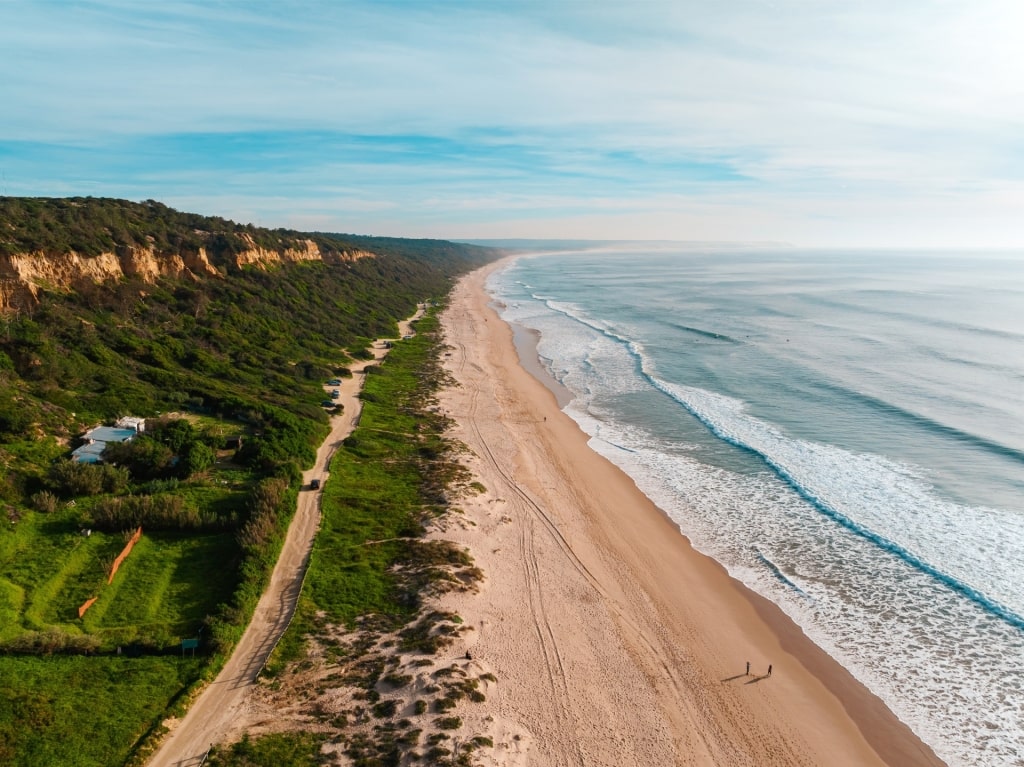
Costa da Caparica
Bohemian beach clubs and youthful energy all add to the allure, but the main pull is the boundless, golden sands that sweep south for a swoon-worthy 15 miles. Complete with seasonal lifeguards, bathrooms, and everything you could need nearby, it’s an ideal beach town for families, friends or couples.
For surfers, beach breaks make Costa da Caparica especially popular. Whether you’re looking to rent a board or take your first wave-riding lesson, there are a dozen or so surf shacks and schools ready to oblige.
Matosinhos
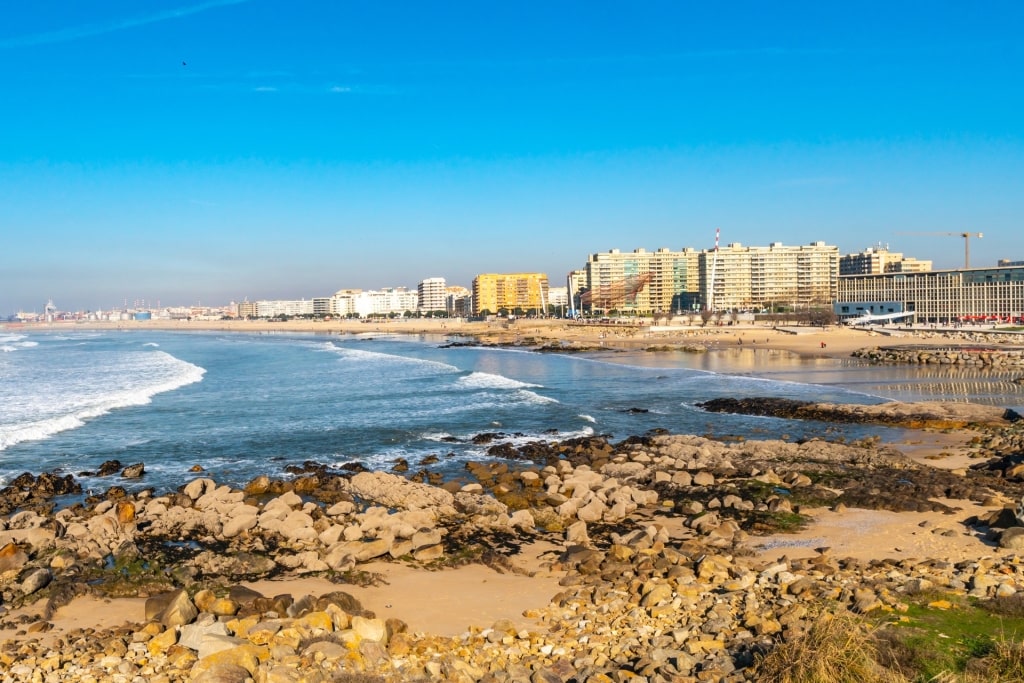
Matosinhos
Quickly reached by metro from Porto, Matosinhos makes the most of the Portugal coast. A working fishing port for centuries, this charismatic beach town—technically now a city in its own right—knows a thing or two about first-class seafood.
For an old-school introduction to Portugal’s beloved conservas, the canned sardines, mussels, and other delicacies served up and down the country, visit Pinhais Cannery & Co.
This traditional sardine tinning factory is home to two of the nation’s most notable brands, and on a guided factory tour, you’ll see, smell, and taste the whole process—and even touch when it’s time to add the finishing labels.
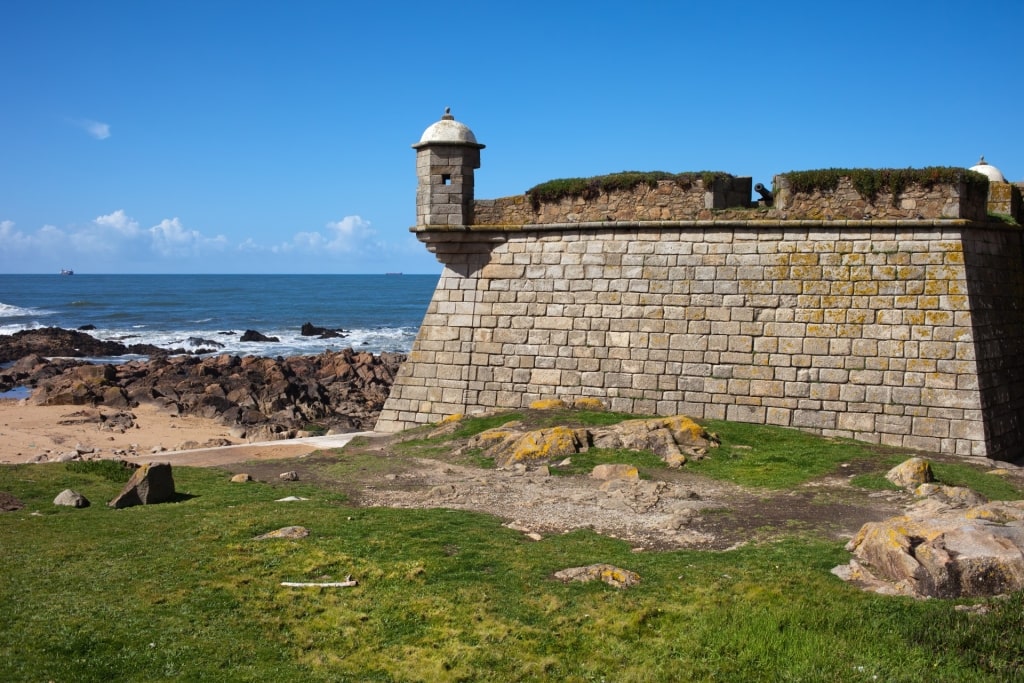
Forte de São Francisco Xavier, Matosinhos
Fronting the town is the urban beach of Praia de Matosinhos, an arc of golden sand splashed by swell. Stroll to the far end to visit the 17th-century Forte de São Francisco Xavier, a sturdy fortress with fantastic Atlantic views from the bastions.
For a little shade, retreat to the ample city park, Parque da Cidade do Porto, just behind the fortress. Beyond the Sea Life Aquarium, the park features small ponds and shaded grass, perfect for a picnic.
Ponta Delgada
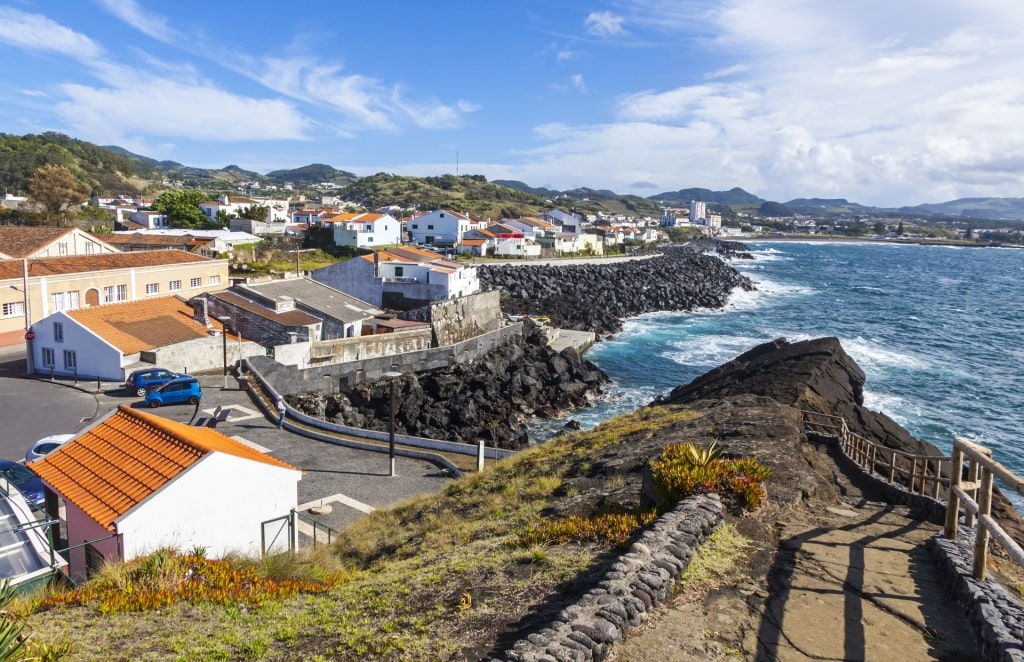
Ponta Delgada
While Ponta Delgada—the de facto capital of Portugal’s nine-strong Azores archipelago—is technically a city, it retains the charisma of a smaller town.
This is especially true in the historic center—which became São Miguel Island’s capital in 1546 after an earthquake destroyed the nearby, original main city—where basalt and limestone churches and heritage buildings sit alongside traditionally decorated restaurants.

Portas da Cidade, Ponta Delgada
Notable landmarks to visit include the trio of ocean-facing fortresses that have long defended the city, the Carlos Machado Museum, and the Portas da Cidade, the original 18th-city arched city gates that now stand independently in a pretty square.
Ponta Delgada’s best features, however, are gifted by nature. On the city’s periphery, you can tour fragrant pineapple plantations and botanical gardens or even venture deep underground inside the Gruta do Carvão lava tube, a testament to the volcanic nature of these isles.
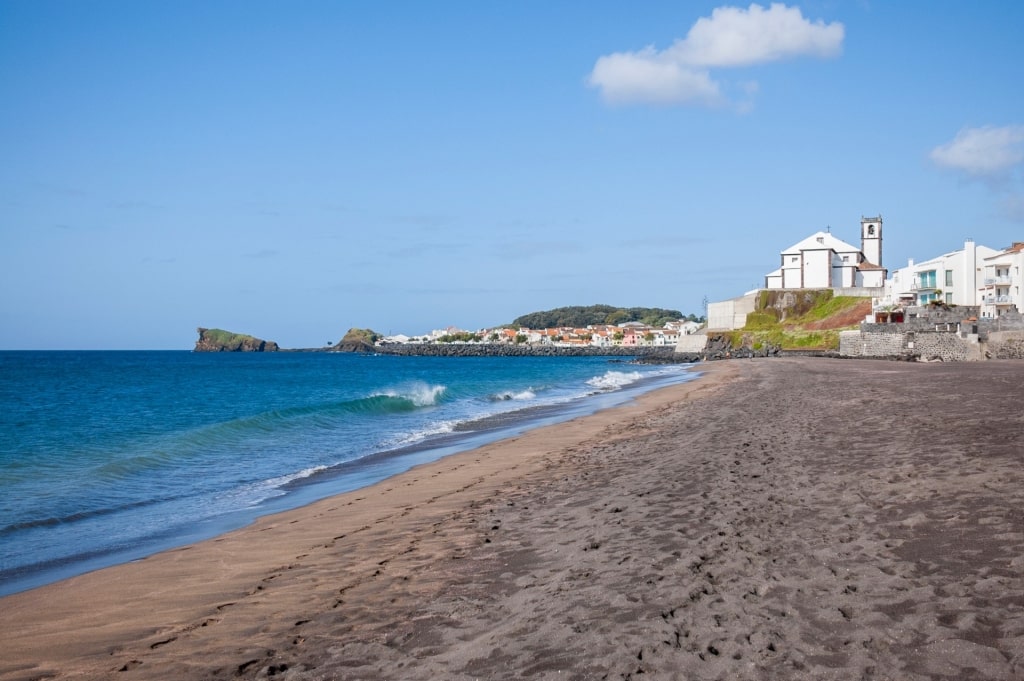
Praia das Milicias, Ponta Delgada
The volcanic theme continues across São Miguel Island’s charcoal-hued sands and pebble shores. Praia das Milicias, a popular beach in the Azores, is just a short drive from the town.
From Ponta Delgada’s marina, wildlife spotting boat trips depart to the deep blue year-round. Dolphins are a common sighting on these tours, yet it’s the chance to spot one of the Azores’ four species of resident whales that makes these sailings so tempting.
Ericeira
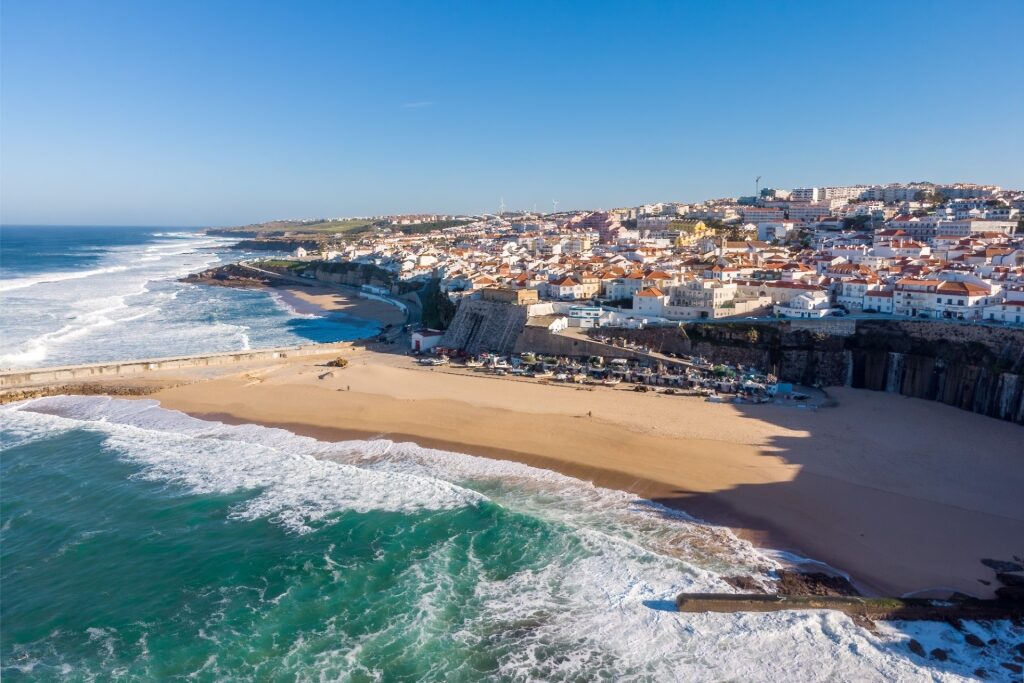
Ericeira
All along the Portugal coast, surfers come to play. But it’s in Ericeira, just an hour north of Lisbon, where much of the magic happens.
Since being designated a World Surfing Reserve in 2011—the second globally designated destination, after California—this former fishing village has grown into a lively tourism hub.
However, it’s not only swell seekers that will fall in love with Ericeira. The pretty whitewashed streets, windows edged in dark cerulean, and salt-kissed air of this former fishing village will charm anyone.
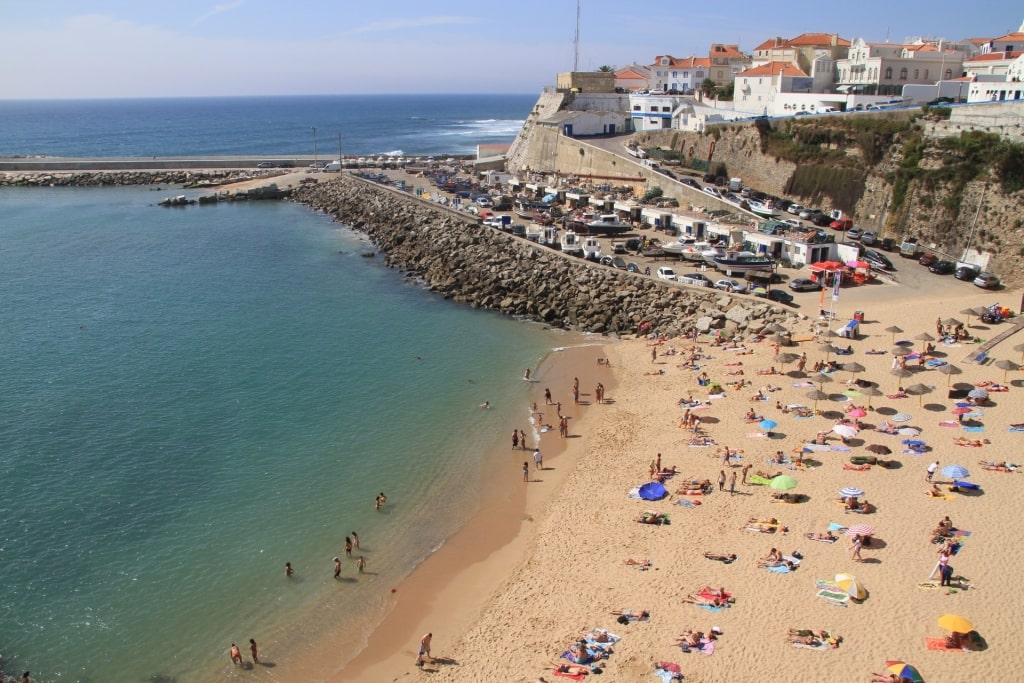
Praia dos Pescadores, Ericeira
Best of all, for those looking to bathe, the town’s main beach at Praia dos Pescadores is sheltered by a seawall, guaranteeing calmer waters than those found on the exposed surf beaches on either side.
Seafood is, unsurprisingly, fantastic here. Yet due to the international crowd, you’ll also find more contemporary options such as smoothies and acai bowls, craft coffee roasters, and vegan burger joints speckling the town.
Ericeira is easily combined with Mafra National Palace, a 15-minute drive inland. This vast, monumental baroque monastery is a marvel and affords a less crowded peek into Portugal’s royal history than Sintra’s palaces.
Ponta do Sol
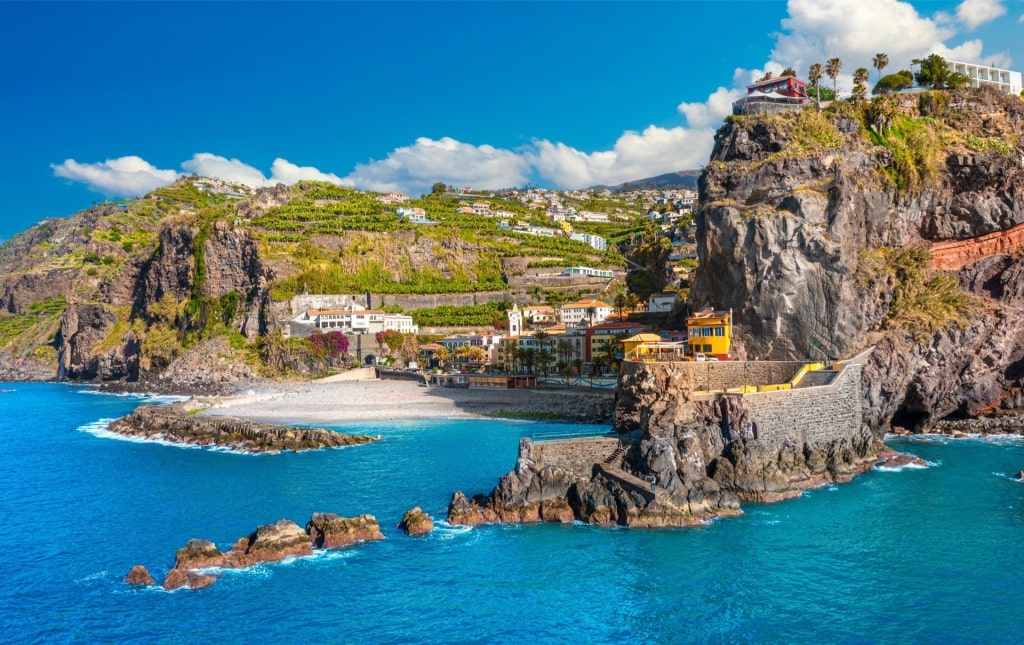
Ponta do Sol
Madeira’s sun-drenched south coast is speckled with some of the prettiest beach towns in Portugal, but few come cuter than Ponta do Sol—regarded as the sunniest point on the island.
Wedged between verdant slopes, the town of pastel colored homes meanders through the valley toward the Atlantic Ocean, where you can dine overlooking the water on the blue balcony of Restaurante Sol Poente.

Ponta do Sol
While the beach is mainly composed of polished dark pebbles—water shoes are recommended—the seawall-guarded bathing area, bathed in sunshine, is a refreshing delight. A ladder nearer the restaurant provides a more comfortable entrance point.
After splashing and sunbathing, join seemingly everyone in town on the beachside bar’s deck for a fruity poncha or sangria, soundtracked by lapping waves.
Vila do Conde
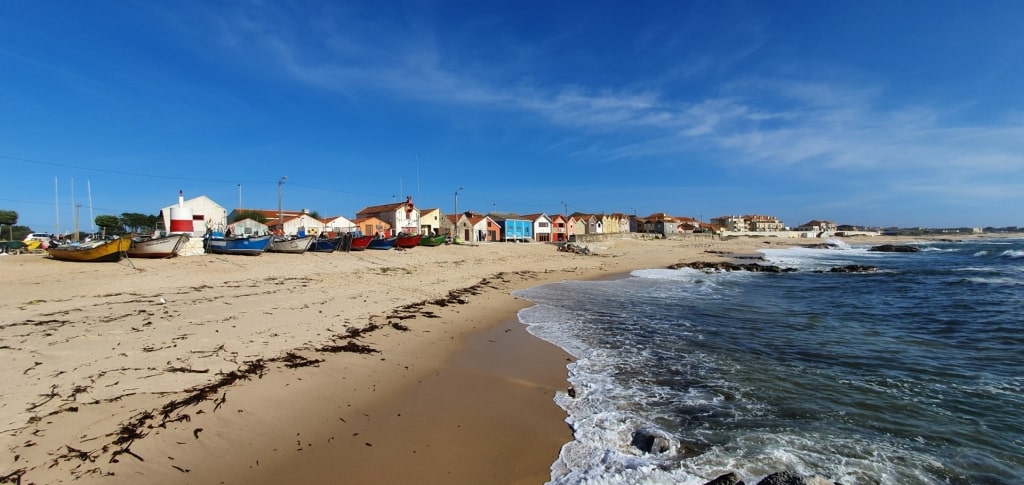
Vila do Conde
Set on the Costa Verde (Green Coast), named for the lush vegetation which backs this stretch of the shoreline, Vila do Conde is one of the best beach towns in Portugal’s north for those chasing a combination of coast and culture.
Just a 50-minute metro ride from Porto, this is an easy day trip from the country’s second city. Hugging the rambling River Ave, the town tracks the waterway towards the ocean, golden sands flanking either side of the river’s mouth.

Forte de São João Baptista, Vila do Conde
Follow the river’s flow and make a beeline to one of the beaches fronting the town, such as Praia do Seca, overlooked by the 16th-century Forte de São João Baptista. Ocean-facing bars line the beach, with the local and lightly sparkling Vinho Verde the perfect pairing on a summer’s day.
Another of the town’s main attractions is the Mosteiro de Santa Clara and its impressive aqueduct. The complex’s church was constructed in the 14th century, with the imposing monastery following later. Today, it’s regarded as one of the finest Gothic structures in Northern Portugal.
Read: Best Beaches in Porto, Portugal
Azenhas do Mar
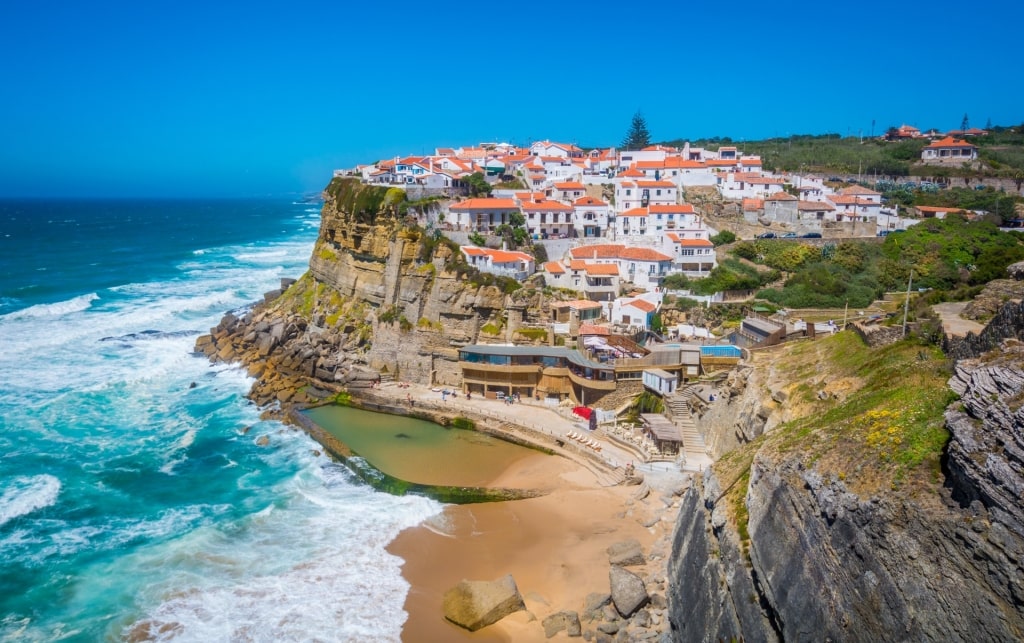
Azenhas do Mar
Less than an hour from Lisbon, clifftop-crowning Azenhas do Mar is not only one of the best beach towns in Portugal but a strong contender for the country’s prettiest.
Once a small fishing port, the village evolved over the years, maturing into a popular beach getaway for in-the-know Alfacinhas (Lisboners) eager to escape the city.
Nowadays, it’s less of a secret, partly due to the proximity of Sintra’s UNESCO-listed palaces, yet the scenic setting is no less impressive nor adulterated. If you’re looking for one of the most romantic panoramas in this country, this is it.
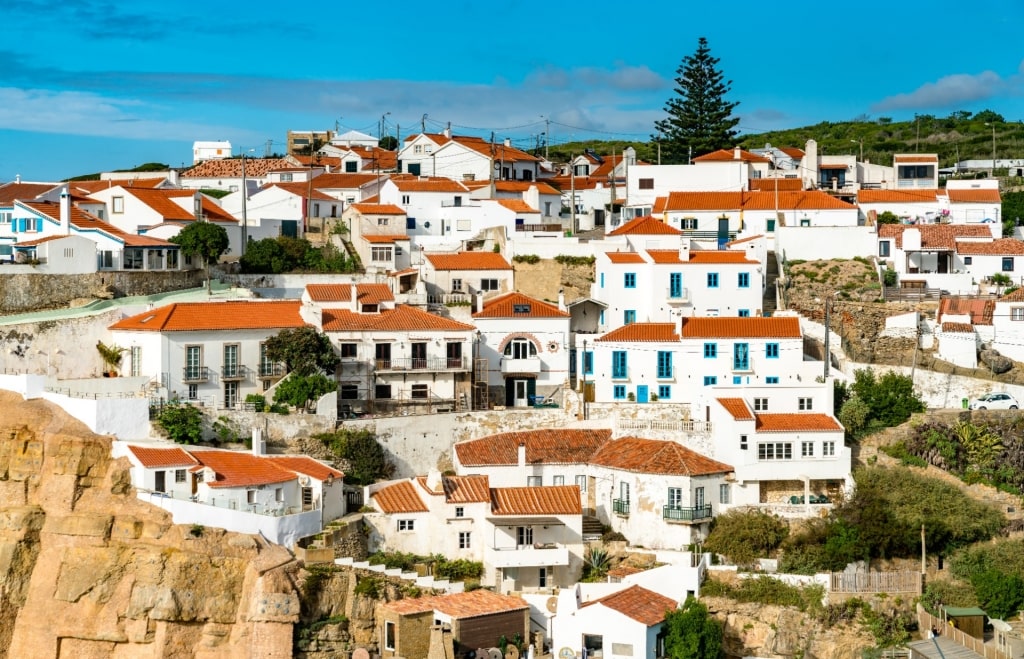
Azenhas do Mar
The cluster of whitewashed homes cascades down the cliff devoid of high-rises or resorts, and an air of authenticity lingers in the salt-infused breeze.
You can still spot occasional remnants of the village’s past—the name translates to “Watermills of the Sea”—by the public restrooms, where a traditional watermill house stands.
Undoubtedly, the main draw is the pocket-sized beach below, which makes for a scenic swim, especially inside the calm lido replenished by seawater. Admittedly, the beach all but disappears at high tide, but the vista remains equally enthralling.
Read: Best Things to Do in Sintra
Ribeira Grande
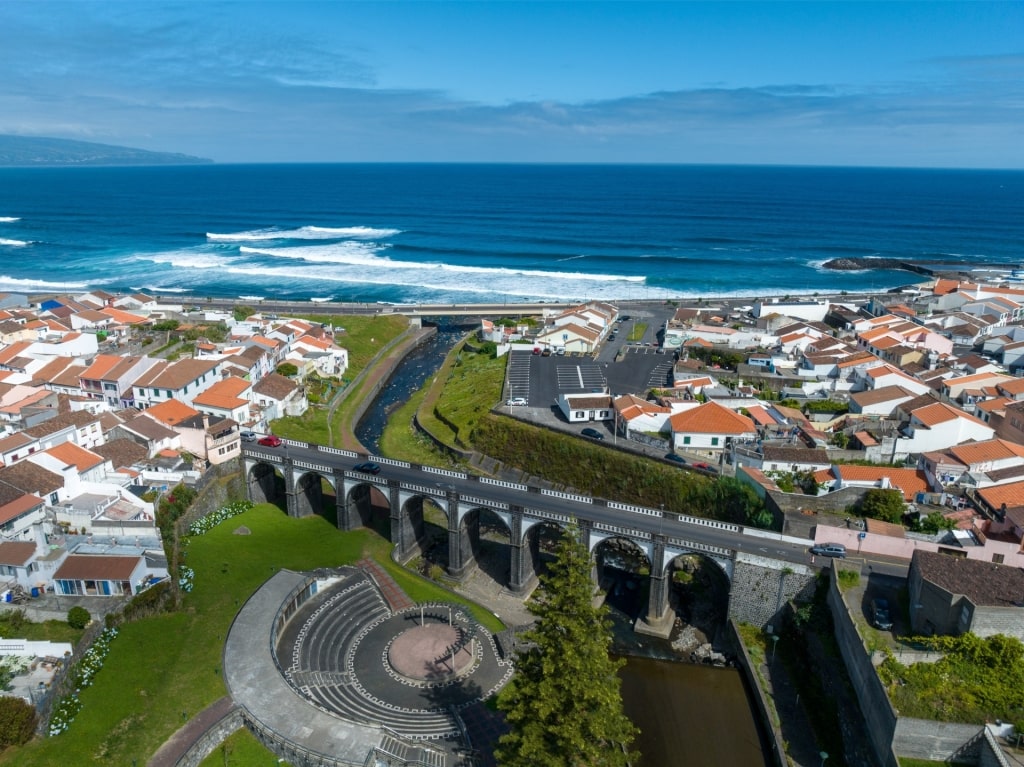
Ribeira Grande
On the ocean- and lava-shaped northern coastline of São Miguel Island, Ribeira Grande paints a striking picture, making it one of the best places to visit in Portugal.
Sliced by its namesake river, the whitewashed, basalt-built town expands out on either side, with an eight-arched bridge, the Ponte dos Oito Arcos, at its center.
Constructed as the second town on the island after Ponta Delgada, Ribeira Grande has plenty of history. Still, the most interesting museum in town is the Museu da Emigração Açoriana, covering the stories of the Azorean diaspora.

Praia do Areal de Santa Bárbara, Ribeira Grande
A short walk west is Praia do Areal de Santa Bárbara, a sensational pocket of wave-rammed volcanic sand that makes Ribeira Grande one of the finest surf beach towns in Portugal.
Settling down on the sun-baked shoreline—or with a glass of the Azores’ volcanic wine at the beach bar—and watching the boards rise and fall is excellent afternoon entertainment. For a more hospitable swim, pick the enclosed Lido Piscinas Municipais to the east.
Sesimbra
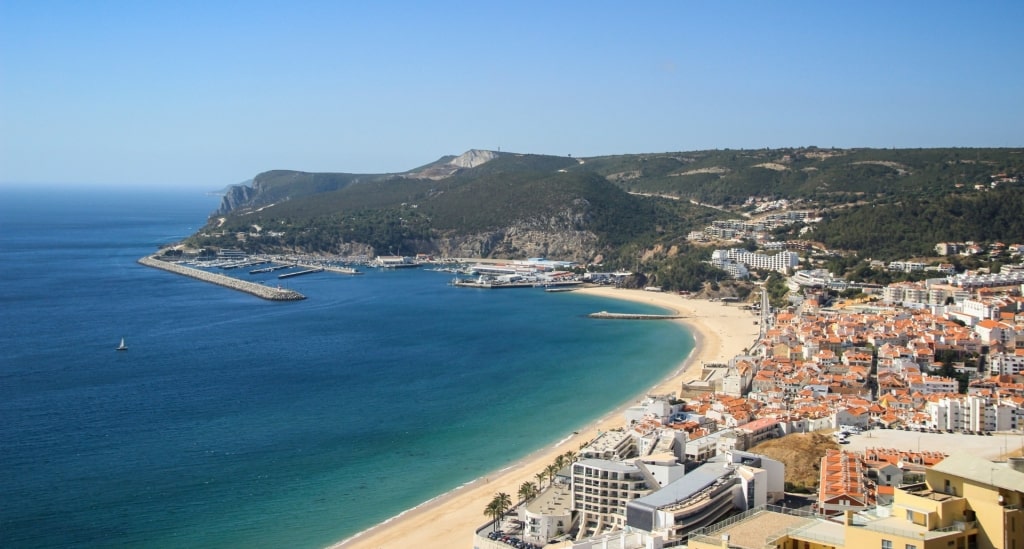
Sesimbra
A popular day trip from Lisbon, peaceful Sesimbra serves up all the seaside essentials you could wish for.
Tranquil turquoise waters lap on the gently curved shoreline, green-clad slopes cradle the town, and marisqueiras (seafood restaurants) grill the day’s catch to order. Choco frito (fried cuttlefish) is the local speciality, with the dishes roots in the nearby city of Setúbal.
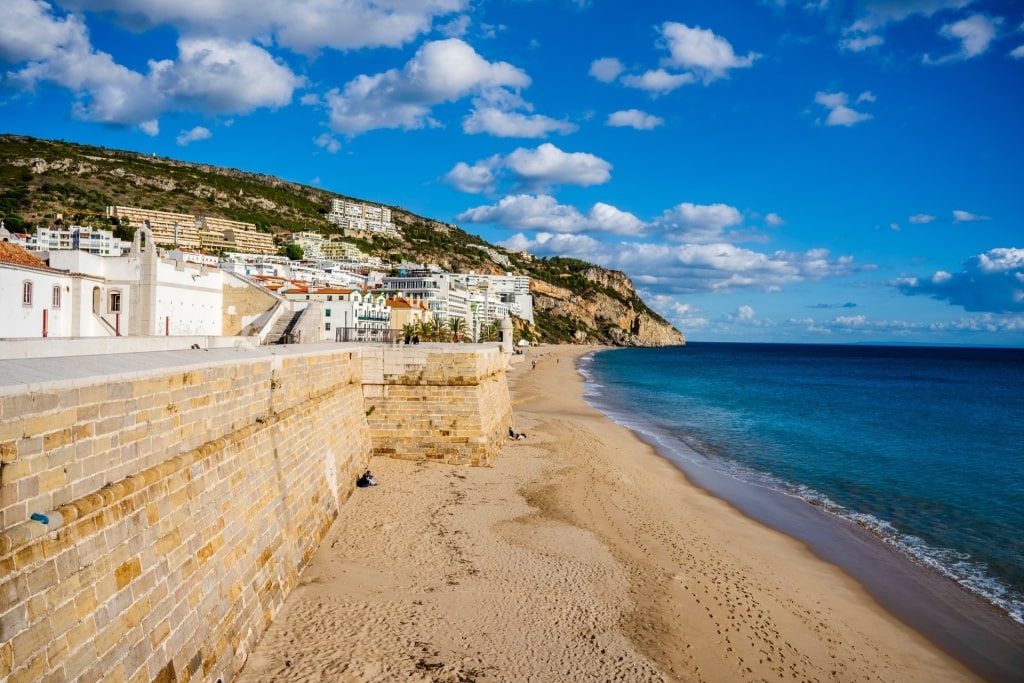
Forte de Santiago, Sesimbra
Fronting Sesimbra are some of Portugal’s best beaches, Praia do Ouro and Praia da Califórnia, separated by Forte de Santiago.
A nearly 300-year-old defensive structure, this fort has been reimagined as an open to all cultural space. High above, medieval Castelo de Sesimbra also stands guard, now providing an incredible panorama across the bay.
Still, what makes Sesimbra one of the best beach towns in Portugal is its surroundings, the Parque Natural da Arrábida.
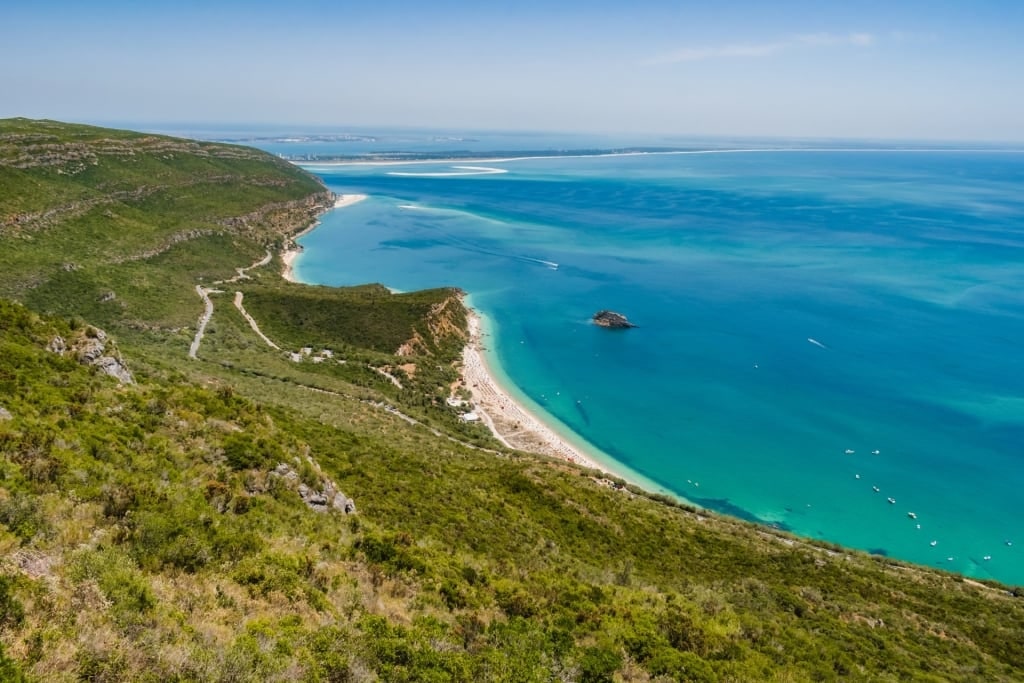
Parque Natural da Arrábida
This lush and mountainous reserve, densely coated by vegetation, is a haven for wildlife and beachgoers, and you’ll find some of the country’s most Caribbean-esque sands inside the park’s embrace.
Families, romantics, and water sports lovers will all find delight in Arrábida’s sandy bays, thanks to the sheltered, calmer, and slightly warmer waters than those on the west coast.
Comporta
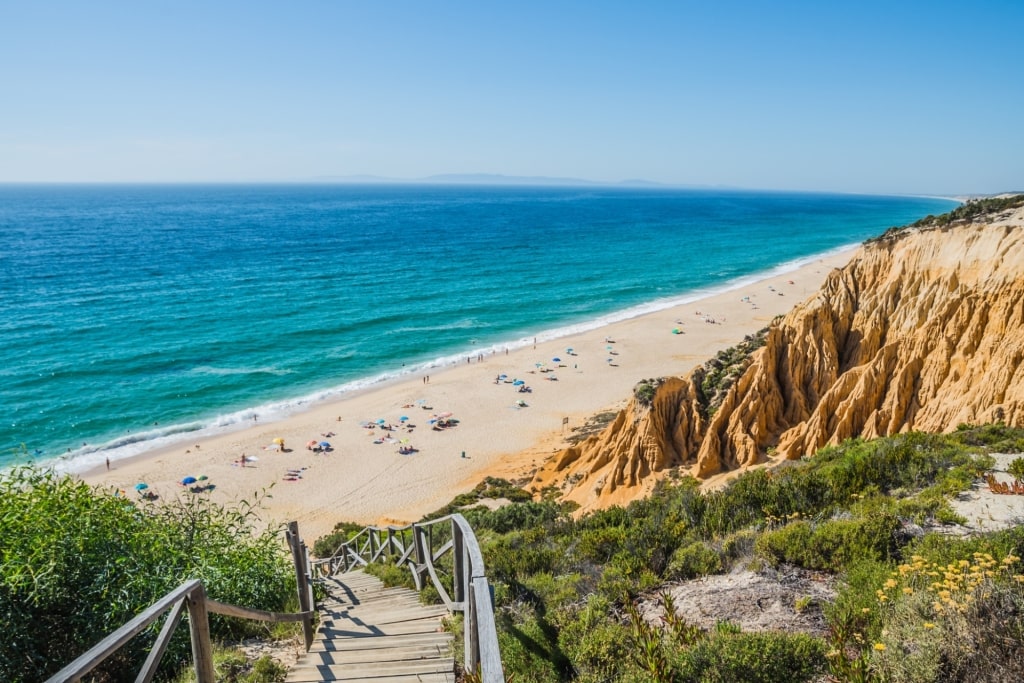
Comporta
In Comporta, nature sprawls out around the Tróia Peninsula, the idyllic sandbar-like view in the distance from Sesimbra.
On one side, breezy white sand shores stretch as far as the eye can see, while the other harbors Portugal’s largest rice paddies. It’s the kind of place where holidaymakers and time-honoring agricultural workers co-exist.
Flop on dreamy, dune-backed Praia da Comporta by all means, but be sure to save time to visit the rickety wooden piers and boats on the lagoon side at Cais Palafítico da Carrasqueira to see how little has changed in decades.
In the rice terraces between the beach and the village, a small museum details the history of production in the region. Sample it with an arroz de marisco, or seafood rice stew, a popular Portuguese dish served at Restaurante São João.
Costa Nova (Aveiro)
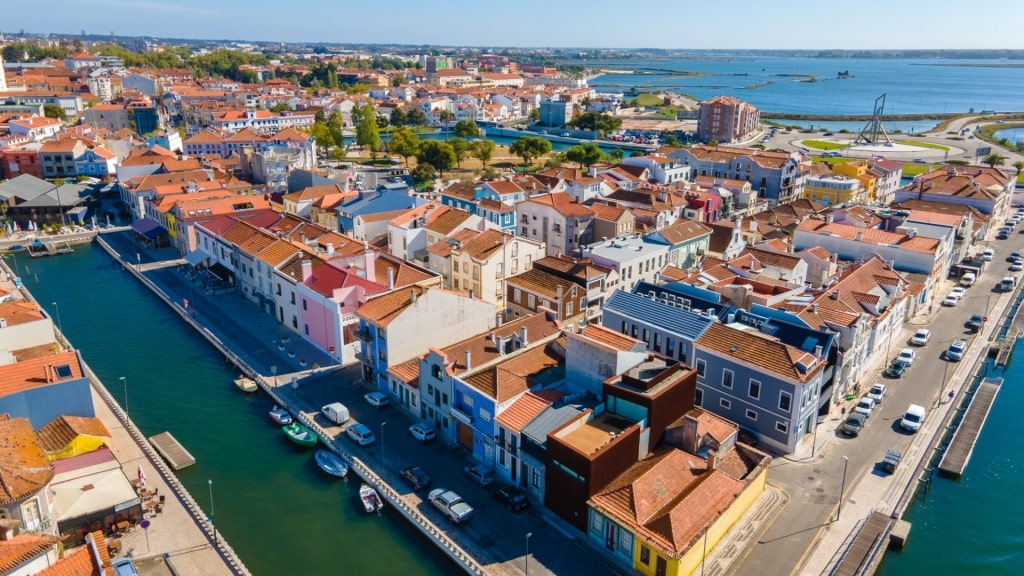
Aveiro
Aveiro, an hour south of Porto, is often dubbed “the Venice of Portugal” thanks to its cluster of canals and hand-painted, high-prowed boats. But if you track those channels away from the art nouveau downtown, you’ll soon arrive at the equally colorful and enchanting Costa Nova peninsula.
Characterized by palheiros—striped two-tone cottages historically used to house fishermen and their equipment—the suburb retains some of its sleepy fishing village qualities.
However, following the salt trade boom of the 19th century, Costa Nova grew and is now often classed as one of the best beach towns in Portugal in its own right.
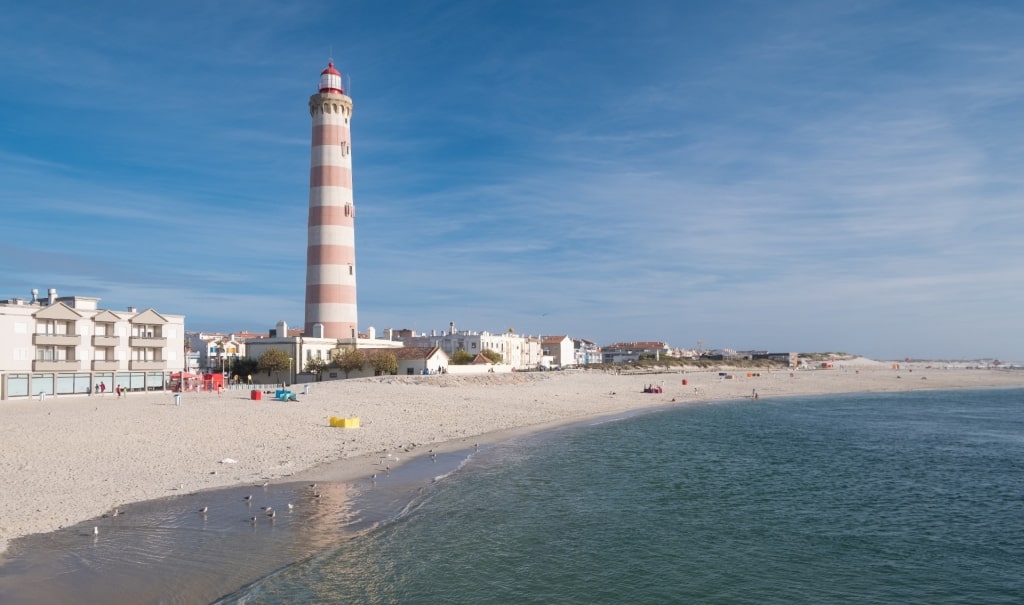
Praia da Barra, Aveiro
Beyond the typical cabins and premium seafood restaurants, the main draw is the pristine, dune-backed beach. On the Atlantic side, surf-friendly Praia da Barra blends into Praia da Costa Nova, creating a streak of sun-bleached sand as far as the eye can see.
Alternatively, settle on the Aveiro Lagoon for a more tranquil setting, where watersports and bird spotting are the order of the day. The lagoon’s calmer waters are ideal for family activities, including boat rental, while surfers will be spoiled along the Atlantic stretch.
For a spot of culture and to learn more about Portugal’s beloved bacalhau (salted cod fish), visit the Navio-Museu Santo André, housed onboard a decommissioned fishing trawler.
A further 15 minutes south is the larger Museu Marítimo de Ílhavo, featuring traditional boats, a codfish aquarium, and exhibitions about the region’s salt trade.
Santa Cruz
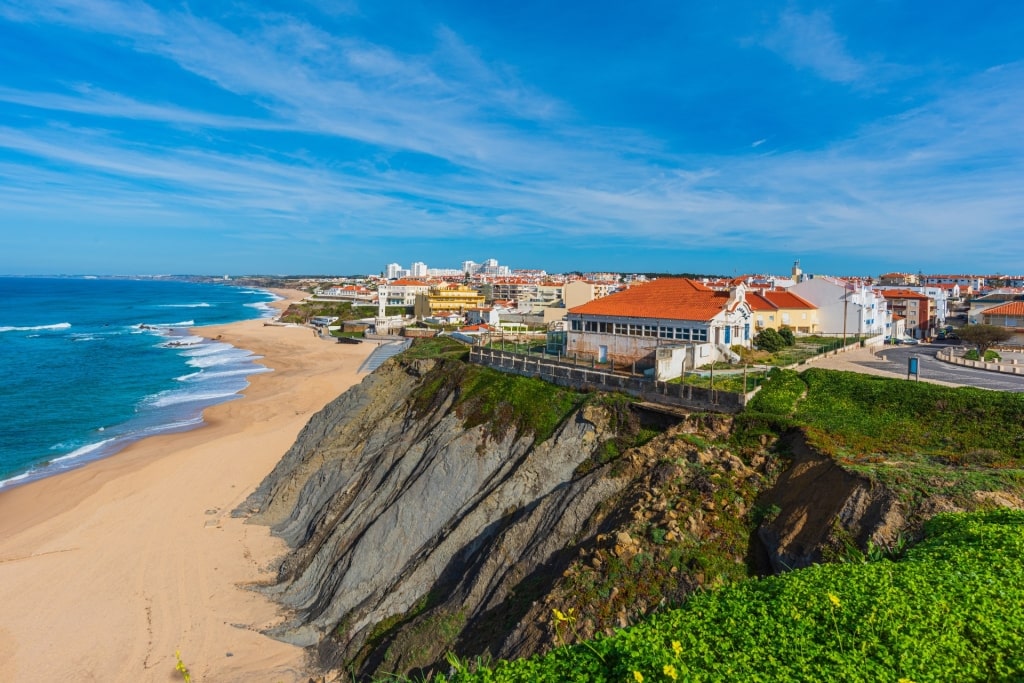
Santa Cruz
A touch north of Ericeira, Santa Cruz has all the same charm—and decent surf—but retains more of a Portuguese fishing village personality. Think of it as Ericeria’s little sister.
Beaches are especially blissful here, and there’s no need to travel far. A few minutes from the clutch of whitewashed streets is Praia da Santa Helena, perfect for a post-lunch dip.
Bookending the beach are dramatic rock formations, including the emblematic Penedo do Guincho, a pierced boulder at the southern end.
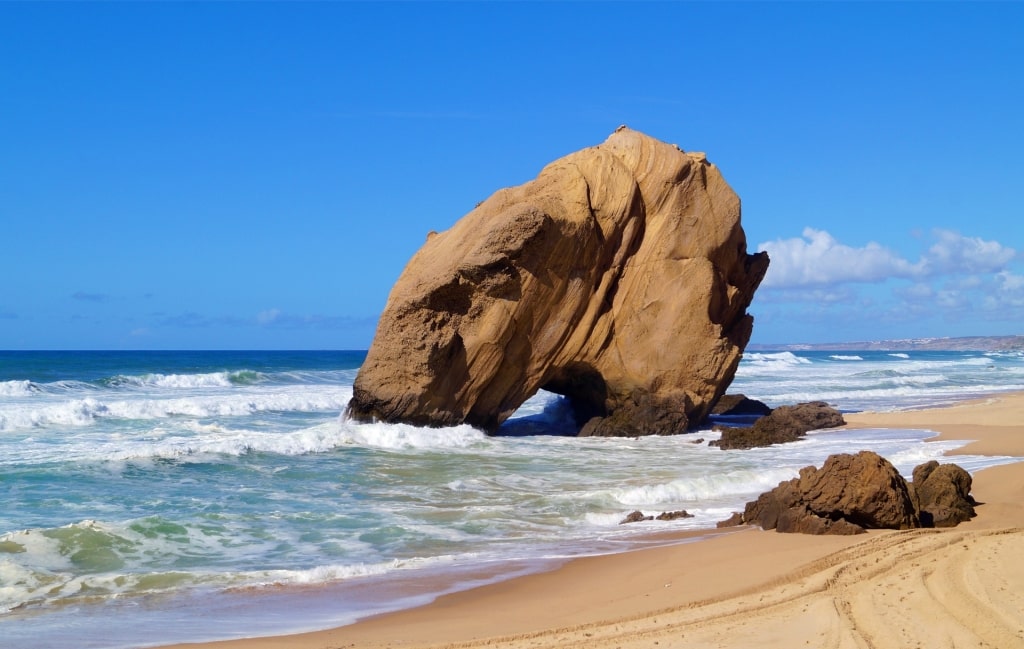
Penedo do Guincho, Santa Cruz
Still, with the highest density of pollution-free certified bathing spots in the country, there are plenty more nearby shorelines to select from.
Saunter south—admiring the coastal bluff viewpoints along the way—and you’ll reach paradisiacal Praia Azul. With the Atlantic on one side and River Sizandro on the other, it’s arguably the best beach in the area.
Vila Franca do Campo
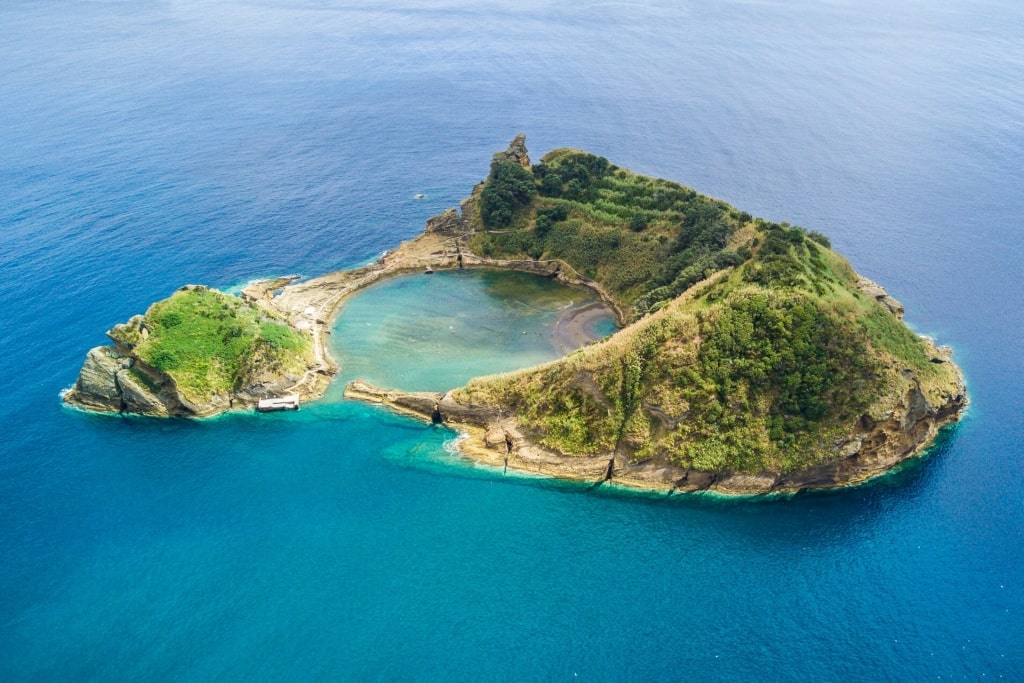
Vila Franca do Campo
On São Miguel Island, the largest of the Azores, Vila Franca do Campo promises a beach town with a twist; the chance to see inside an extinct volcano.
A short boat ride will whisk you to Ilhéu de Vila Franca do Campo, a protected offshore islet open to visitors from late spring until autumn. Formed from the crater of an ancient volcano, this nature reserve is considered one of the most unique places to visit in the whole country.
While the islet’s beach is relatively compact, adding to the intimacy of the setting, the tranquil lake-like waters inside the “cone” offer a respite from some of the Azores’ more surf-heavy shorelines. You can’t swim here but you can snorkel around the outside of the island, giving a unique perspective on this volcanic formation. Access to the island is restricted to 400 people per day so advance booking is essential.
Don’t skip the town itself, either. The dark sands of Praia da Vinha d’Areia beach are backed by a small, family-friendly waterpark, while art-inclined visitors will appreciate the Museu Municipal’s unexpectedly stately interior decor.
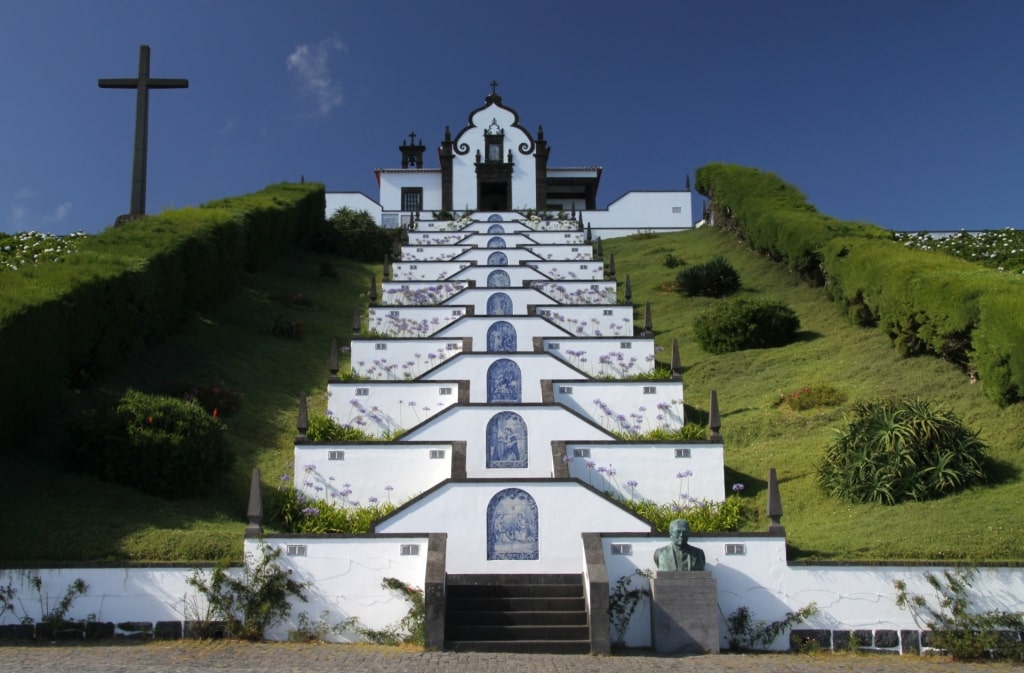
Ermida de Nossa Senhora da Paz, Vila Franca do Campo
Above the town, the Ermida de Nossa Senhora da Paz, an 18th-century hermitage, is worth a visit for the panorama alone. After climbing the intriguingly stacked staircase, you’ll enjoy a fantastic vista across the town and islet.
Post-hike, settle into one of the town’s small tabernas to sample grilled lapas (limpets), one of the Azores’ signature dishes.
Machico
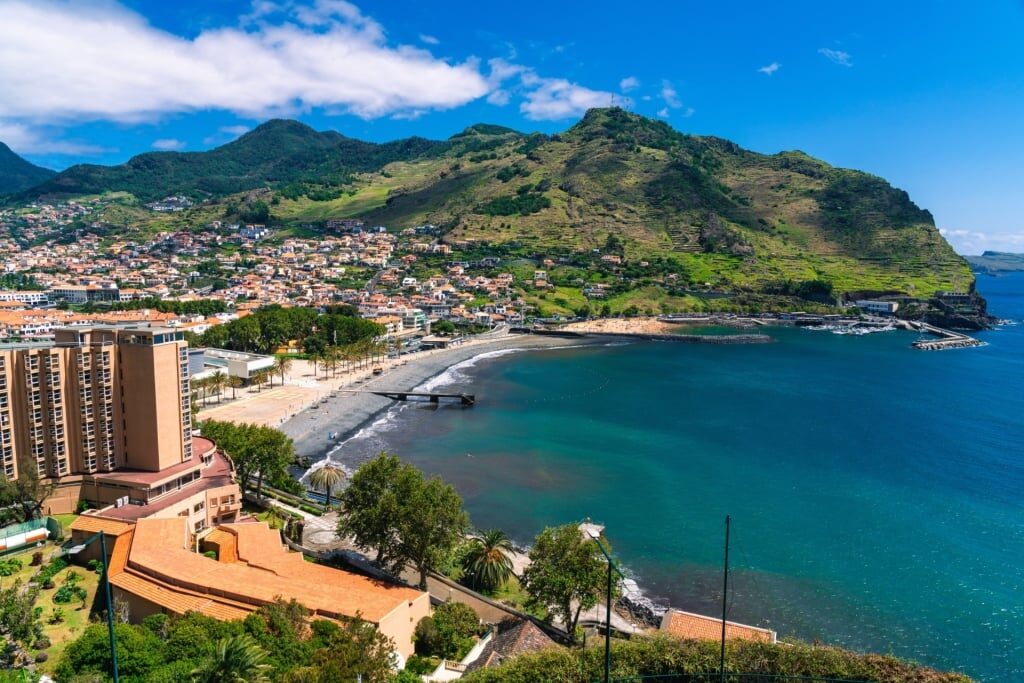
Machico
In southeastern Madeira, Machico cascades through a narrow, verdant valley toward one of Madeira’s rare golden beaches, Praia da Banda Além.
Made of imported soft sand and sheltered by sea defenses, it’s one of the island’s finest spots to swim, sunbathe or simply cool off with an ice cream—Gelati Machico, on neighboring Praia de São Roque, has some wonderful and wacky flavors.
Being the foremost settlement in Madeira and the first capital, a wander through the lower part of town will bring you to historical sights. The 15th-century Matriz de Machico Church and mustard-hued Forte de Nossa Senhora do Amparo, dating to 1706, are of particular note.
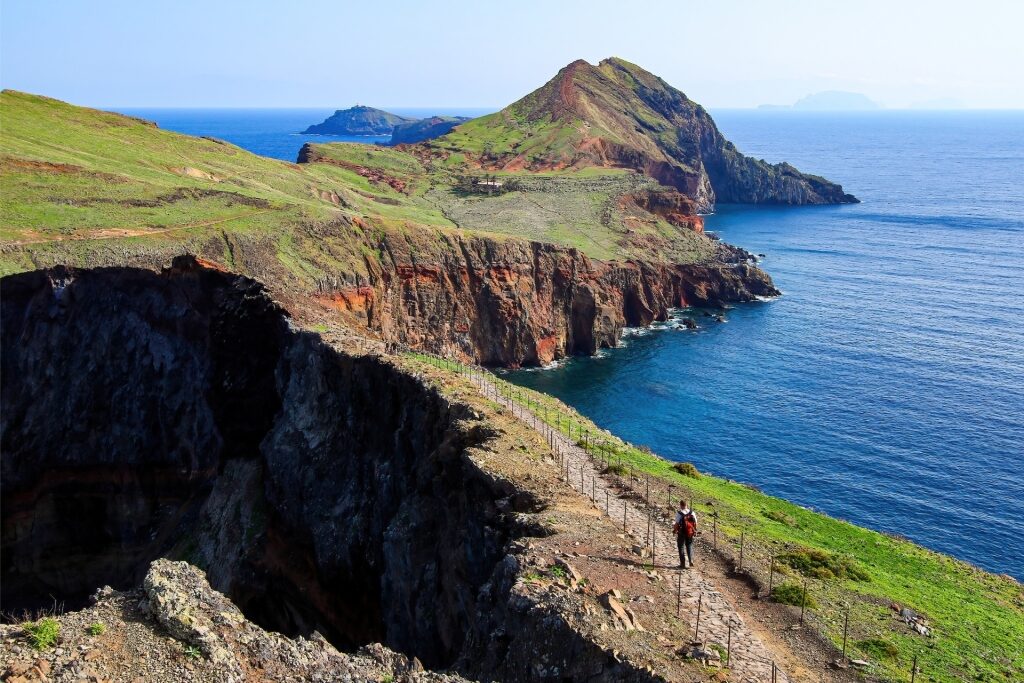
São Lourenço, Machico
If you’d prefer to stretch your legs than trace time, make for the slender, arid São Lourenço Peninsula, snaking east of Machico.
Within this designated nature reserve, you’ll find one of Madeira’s best coastal trails, which passes another pretty beach town, Caniçal, en route to the headland miradouro. Beyond are the “deserted islands,” closed to the public to protect the endangered monk seal population.
Nazaré

Nazaré
Mention Nazaré to any competitive surfer and you’ll be showered with stories of awe. Renowned as the home of the world’s biggest waves—the largest surge surfed here reached an impressive 85 feet—this stretch of coast an hour and a half from Lisbon deserves its legendary status.
The best time to visit Portugal for the most ferocious waves is usually from late September to April, although the spectacle here is enthralling year-round.
Whether you’re taking it in from a surfboard or the viewing area inside Forte de São Miguel Arcanjo, these giant tides will leave you spellbound.

Praia da Nazare, Nazaré
Still, that doesn’t mean that Nazaré is exclusively for wave riders. On the other side of the headland, the much calmer and tanning-friendly Praia da Nazare curves gently in front of the laid-back town.
Seafood restaurants line the promenade, serving up local specialties such as octopus, cod fish, and tuna. Behind, the maze of weathered streets is dotted with small boutiques and independent souvenir stores.
Nazaré is particularly well-known for its sun-dried fish and at the far end of the beach, you’ll often see mackerel or sardines laid out on racks. The small Dry Fish Museum provides further information about the tradition.

Sitio de Nazaré, Nazaré
For a slice of Portugal’s patrimony—and some far-reaching views—ride the 19th-century funicular up to Sitio de Nazaré.
High above the town, the Santuário de Nossa Senhora da Nazaré, originally medieval but since reconstructed, dominates. The tilework inside is particularly exquisite.
Miramar
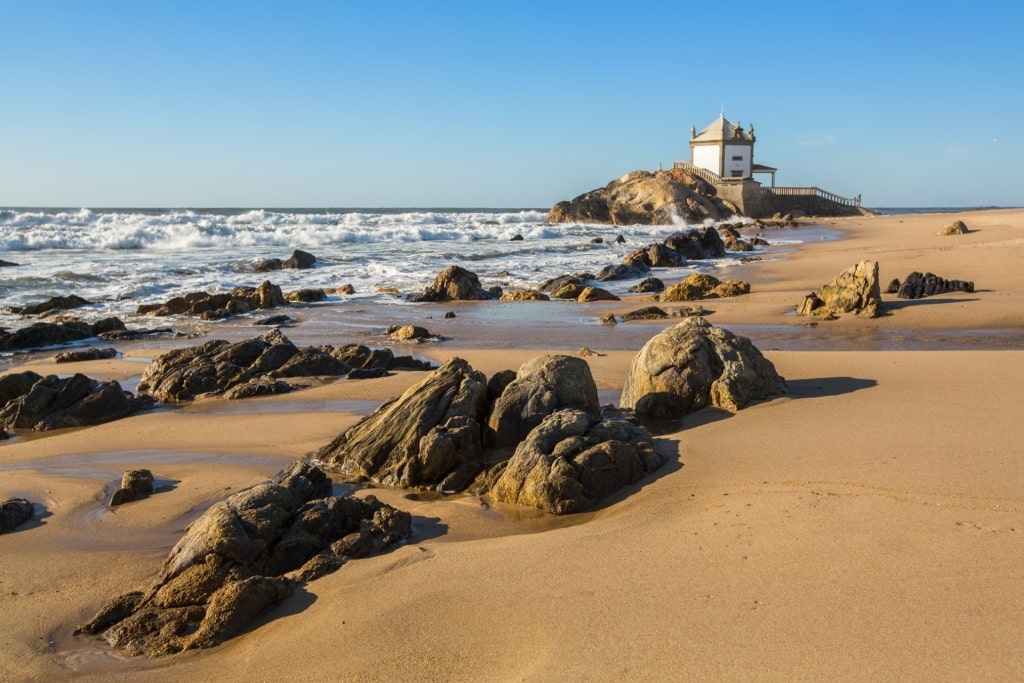
Miramar
Hop on a train at Porto’s Campanha and in under 20 minutes, you’ll be pulling into laid-back Miramar station.
This small seaside village is best known for the small chapel wedged on the sand between Miramar’s namesake beach and Praia do Senhor da Pedra.
Hexagonal in shape, the diminutive, whitewashed chapel has stood here for centuries, perched atop a sea rock to protect it from the Atlantic.
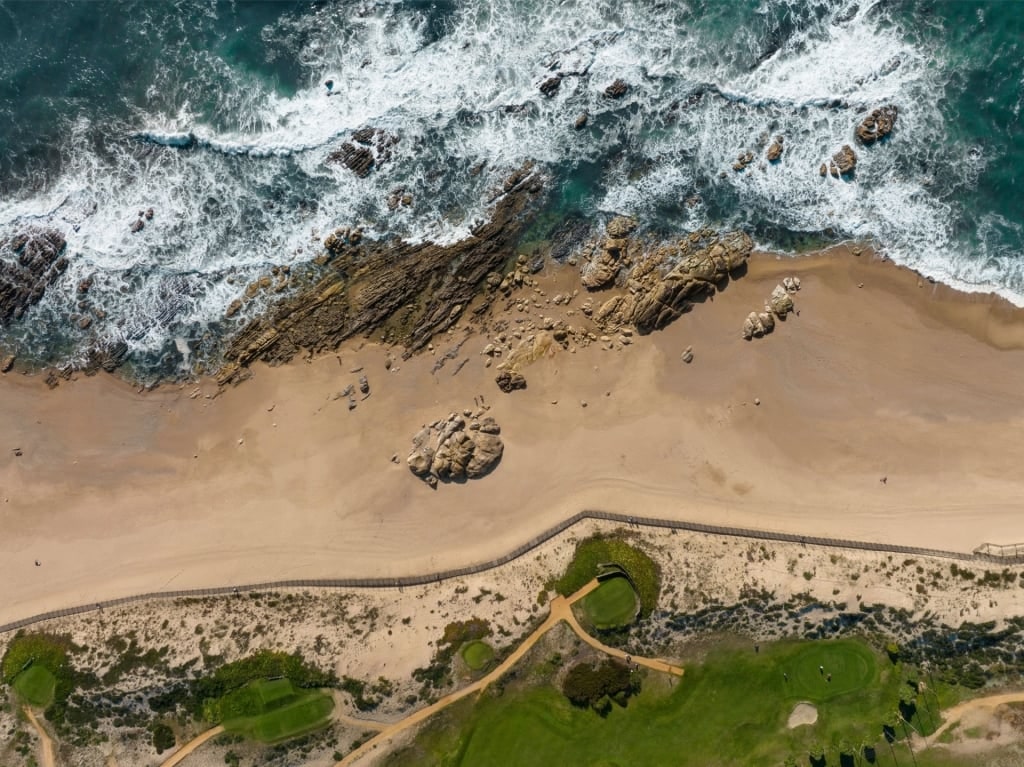
Miramar
Golfers will also appreciate a detour to Miramar. An excellent nine-hole course runs adjacent to the dunes at the town’s southern end, ensuring many holes come with slightly distracting ocean panoramas.
Porto Moniz
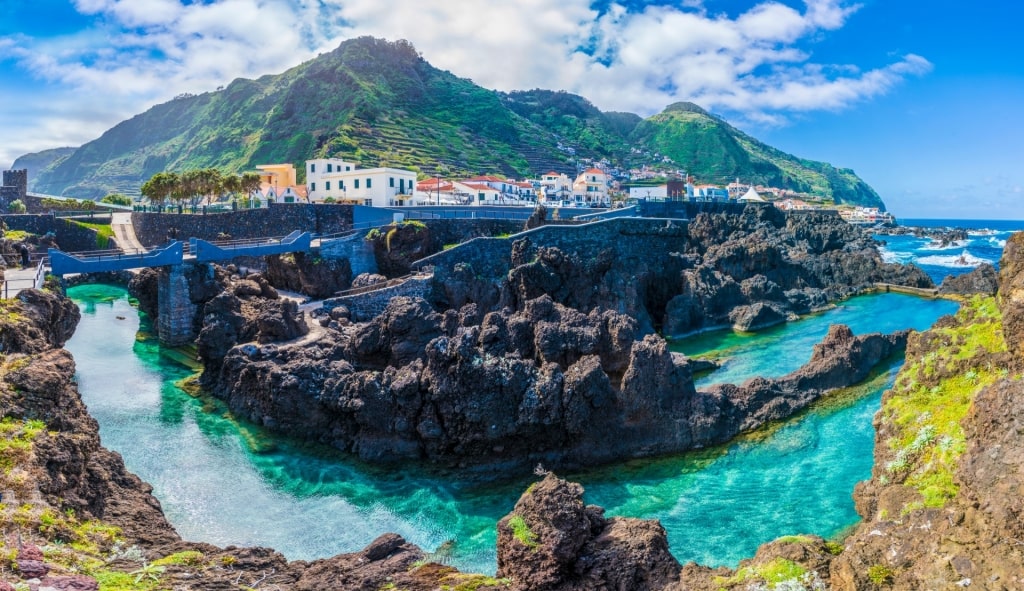
Porto Moniz
With its year-round semi-tropical climate, Madeira has established itself as one of Europe’s best beach destinations. Yet for the island’s most memorable swimming spot, you’ll want to head to Porto Moniz.
Set on the island’s northwest one hour from Funchal, this tiny beach town has been shaped by nature. Crashing Atlantic waves, fierce winter winds, and lava-spewing eruptions have all left their mark, crafting some of the world’s most unique bathing pools.
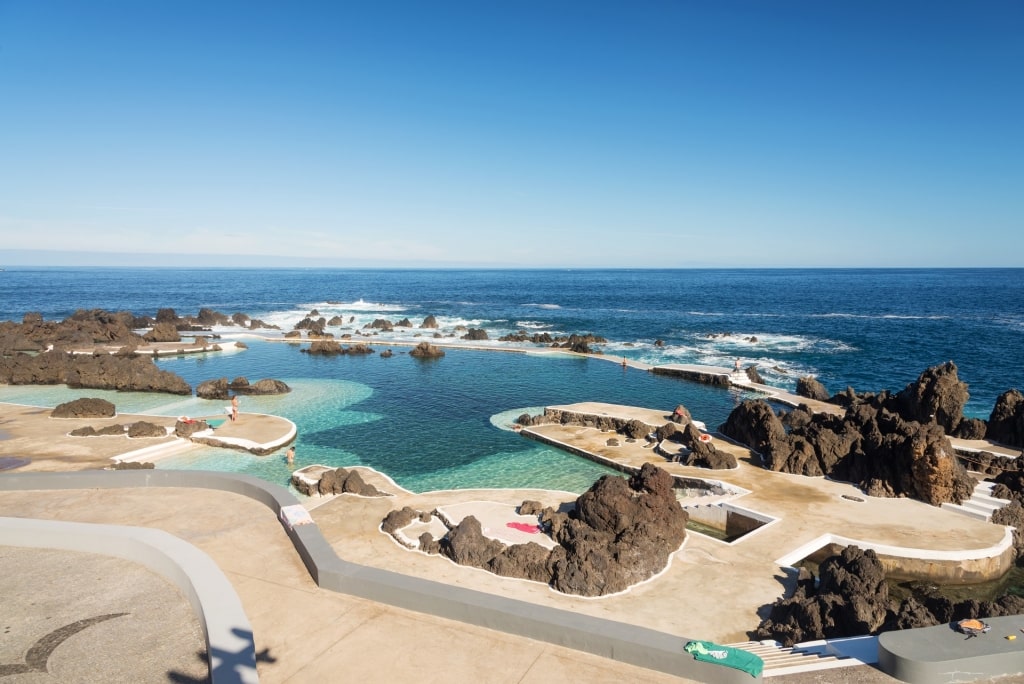
Porto Moniz
Whether you choose to splash into the rugged volcanic pools or the more polished family-friendly version, expect plenty of seawater tumbling over the volcanic-defined borders.
With Madeira’s signature soaring mountains flanking the town, you’ll cherish your experience at one of Portugal’s most beautiful places.
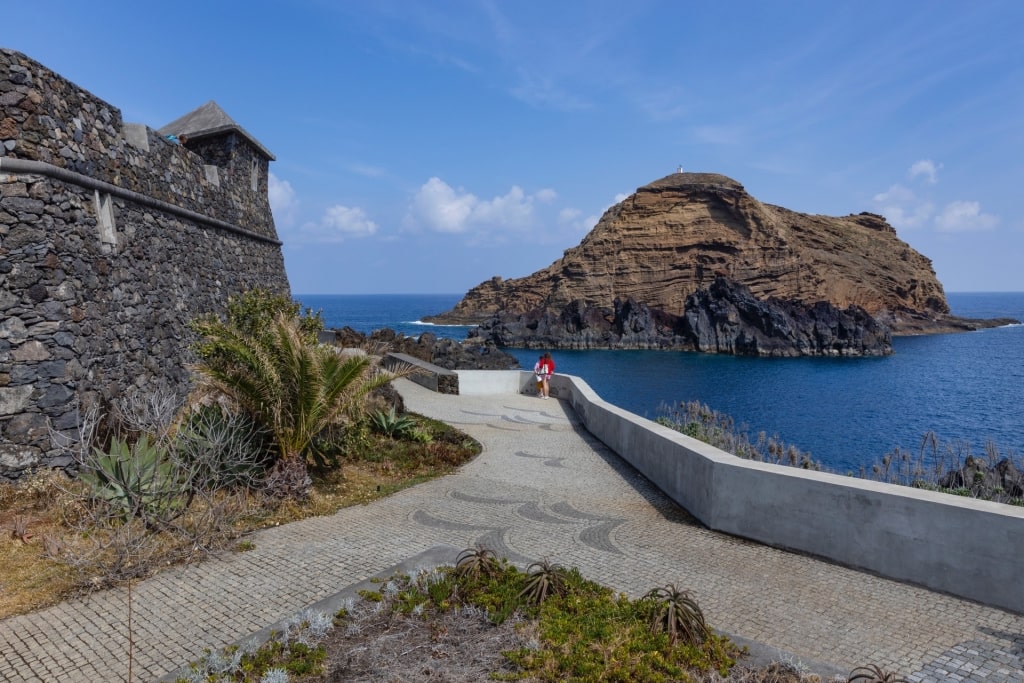
Forte de São João Baptista do Porto Moniz
After enjoying an Atlantic bath, amble atop the Forte de São João Baptista do Porto Moniz, a reconstruction of an 18th-century fort. The construction now houses an aquarium with tanks so big that the on-site LAVA Diving Center offers inside scuba diving experiences.
For more typical sands—and even then, they are the color of cocoa—visit nearby Seixal, where the backdrop of vegetation-coated cliffs and tumbling waterfalls provides another incredible bathing spot.
Peniche
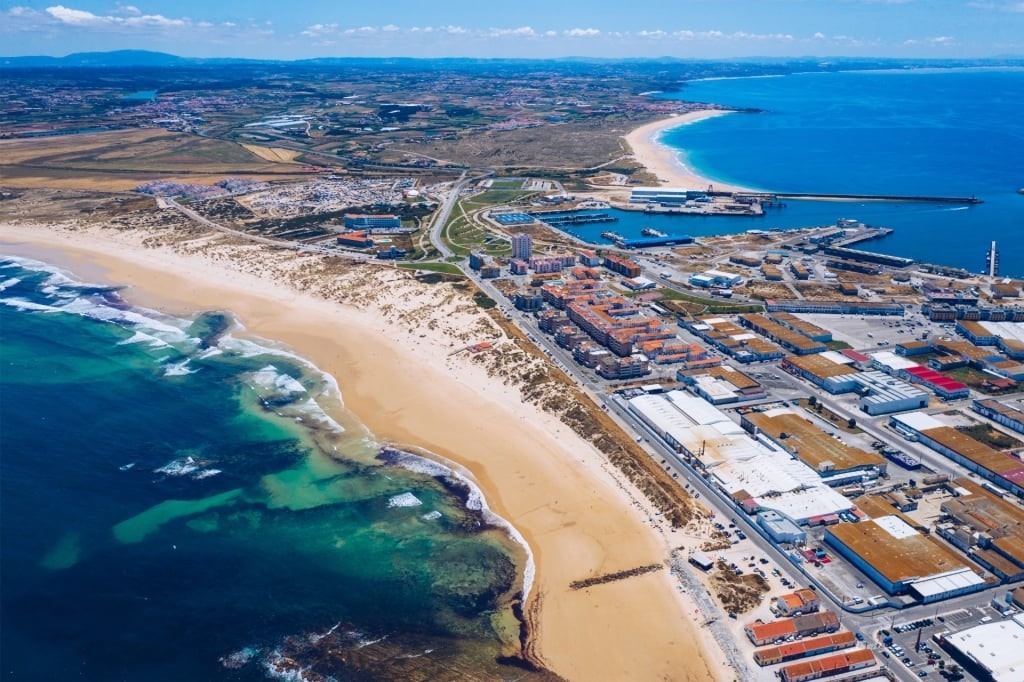
Peniche
Peniche is about as authentic a representative of the Portugal coast as they come. With its wind-whipped headland, mighty fortresses, and fishing community, it has a much more “lived-in” feeling than Ericeira to the south.
Easily added on after touring the nearby medieval town of Obidos, the seafaring headland city is flanked by surf-ripe beaches, including Praia dos Supertubos, a host of the World Surf League event.
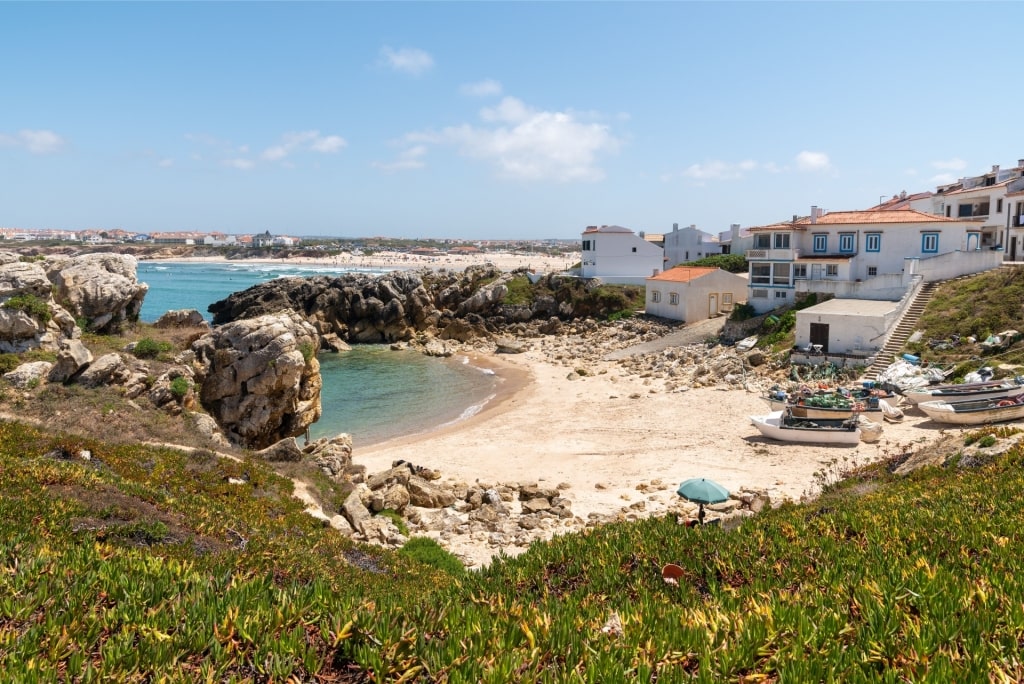
Baleal village, Peniche
If you fancy a calmer water paddle, head north to the tombolo beaches, which link the tiny, ocean-jutting Baleal village with the mainland.
Back in town, visit the drawbridge-accessed fort to tour the Museu Nacional da Resistência e Liberdade, an exhibition dedicated to political prisoners during Portugal’s dictatorship.
Or just sit back and relax with a plate of percebes. These goose barnacles are the local specialty, hand-harvested from the rocks of the craggy Berlengas Islands on the horizon.
São Martinho do Porto
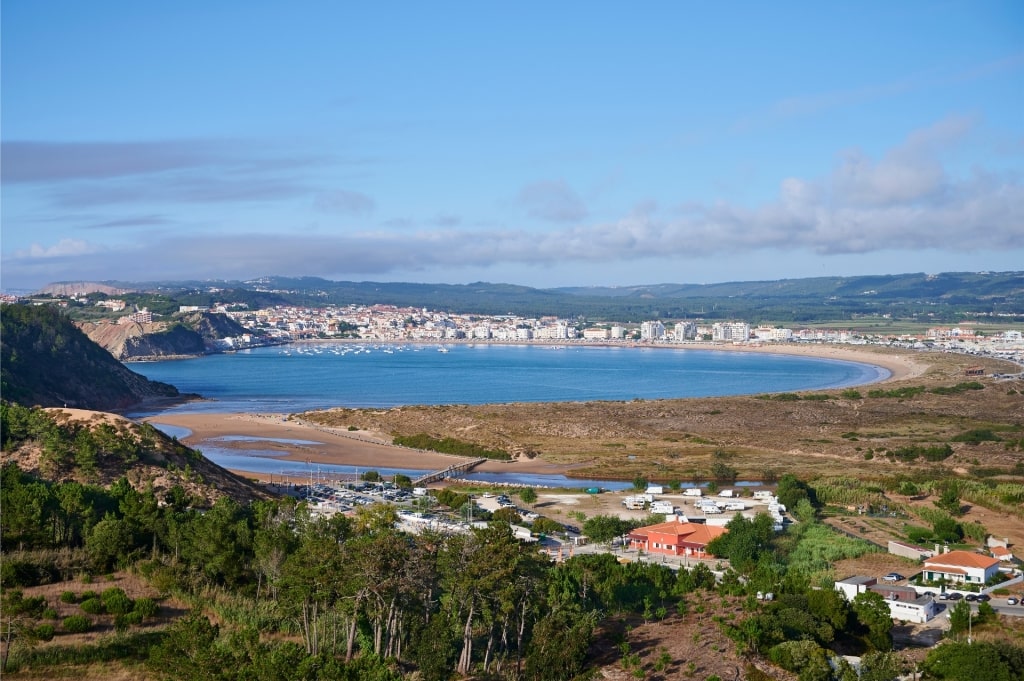
São Martinho do Porto
São Martinho do Porto, 90 minutes north of Lisbon, deserves special mention along the Portugal coast due to the almost unbelievable shape of its harbor.
Two headlands protrude on either side, pointing at each other to create a narrow channel and a perfect scallop-shaped bay rippling onto golden sands.
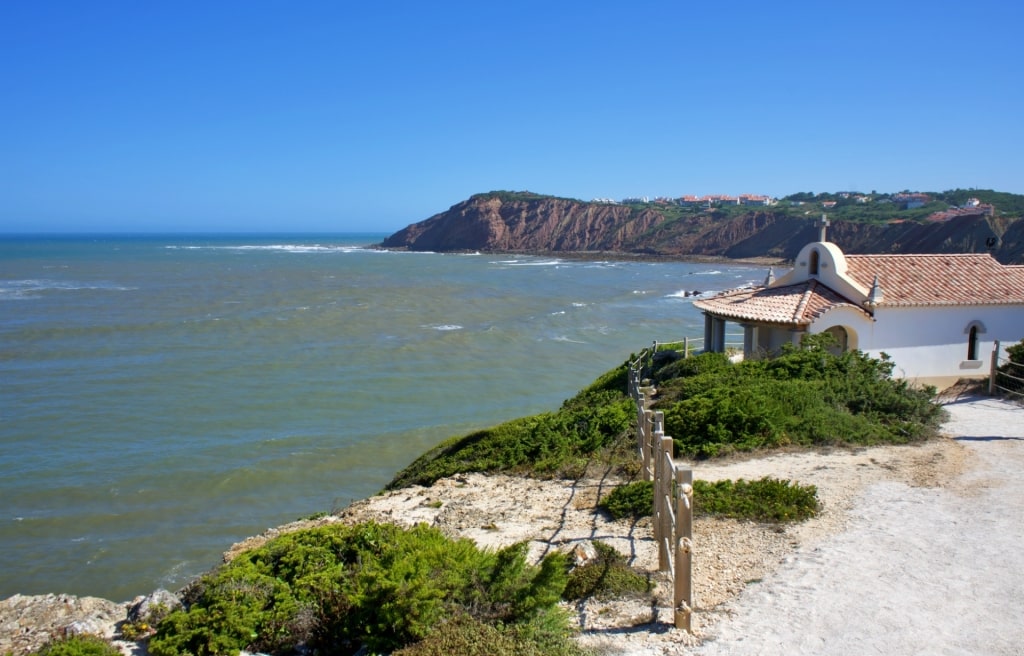
Santa Ana Chapel, São Martinho do Porto
Head up onto either headland for a brief, brisk walk to take in the best views—the southern bluff features the remains of the 12th-century Santa Ana Chapel, while the other offers a more lofty miradouro, or viewpoint.
Looking back at the bay from above, you’ll have a better appreciation of Salir do Porto, the highest dune in Portugal. Reaching 160 feet, this impressive sand structure hugs the River Tornado, which spills into the Atlantic at the beach’s southern end.
Read: Portugal vs. Spain: Which Should You Visit?
Porto da Cruz
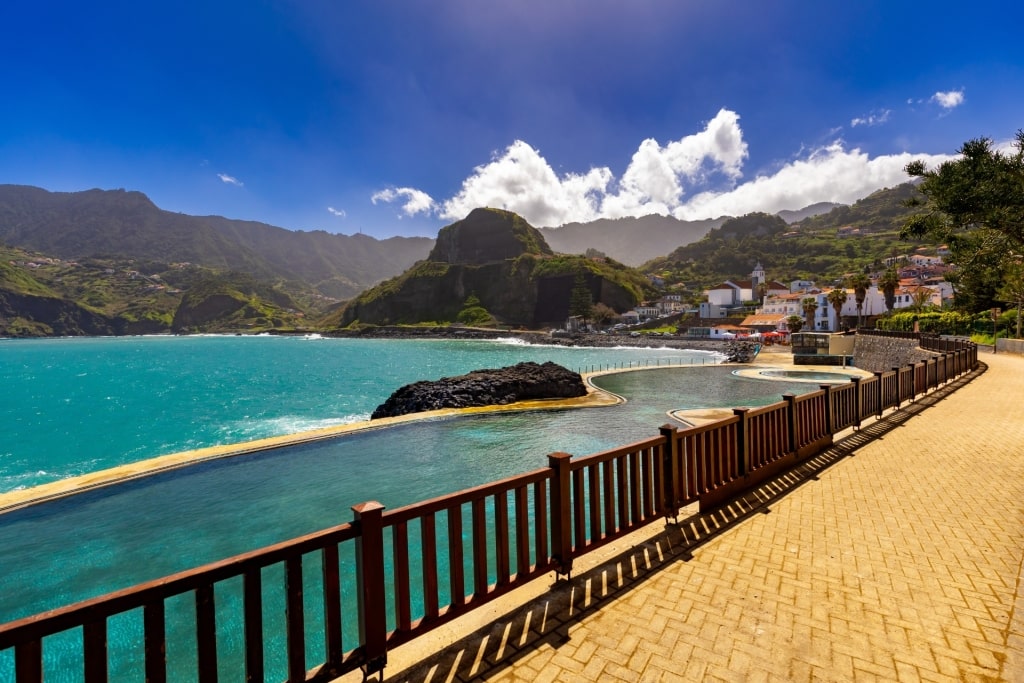
Porto da Cruz
Madeira’s Porto da Cruz is one of the most dramatic beach towns in Portugal. Arriving here, through the jagged mountains and seeing the 1,935-foot high, vegetation-clad Penha de Águia rock formation looming in the distance is mesmerizing.
Set on the island’s northeastern coast, where the waves are wilder, landscapes lusher, and hikes more challenging, it’s primed for adventures, whether you want to splash in the protected lido, rent a surfboard, or hike an imposing rock face.
Or take it easy. Pop into North Mills Distillery and raise a glass of island gin to the Atlantic, thanking it for shaping the Portugal coast into perfection.
Read: Tipping in Portugal: The Ultimate Guide
FAQs
What is the best time to visit Portuguese beach towns?

Ponta do Sol
Portugal’s beach towns are glorious year-round due to their dramatic shorelines and whitewashed appeal. Spring through autumn is when you’ll find the mainland and Azores’ best beach towns most alive, while those on Madeira remain popular in winter due to the more consistent climate.
What is the nicest beach town near Lisbon?
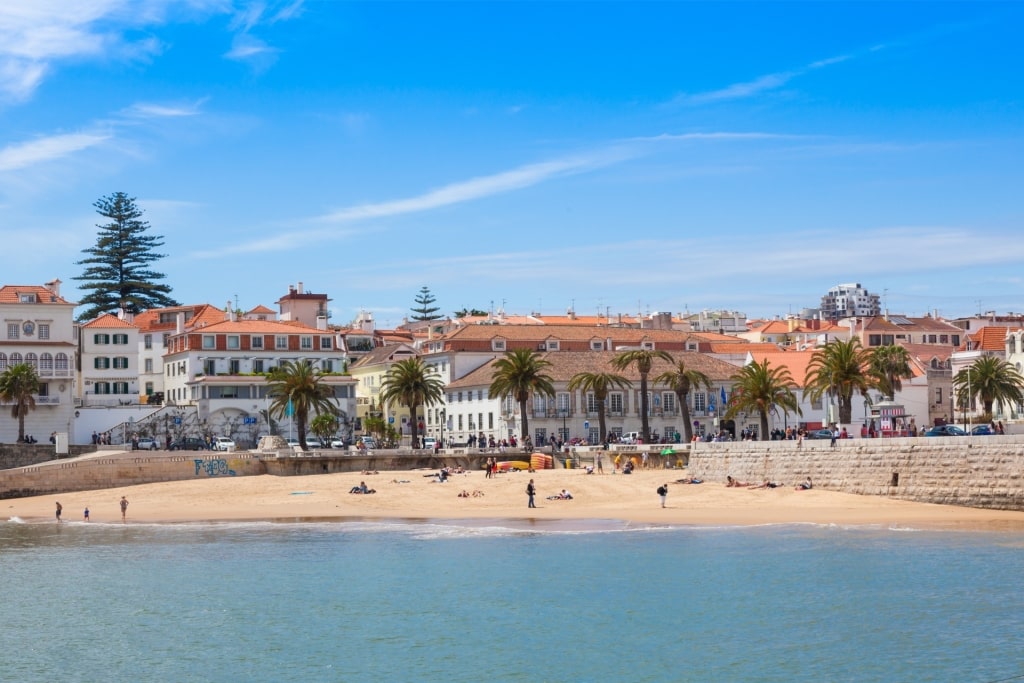
Cascais
The closest beach towns to Lisbon are Cascais and Costa da Caparica. However, the prettiest beach towns near Lisbon are Azenhas do Mar, near Sintra, and Sesimbra, to the south, due to the surrounding beaches of the Parque Natural da Arrábida.
What is the nicest beach town near Porto?
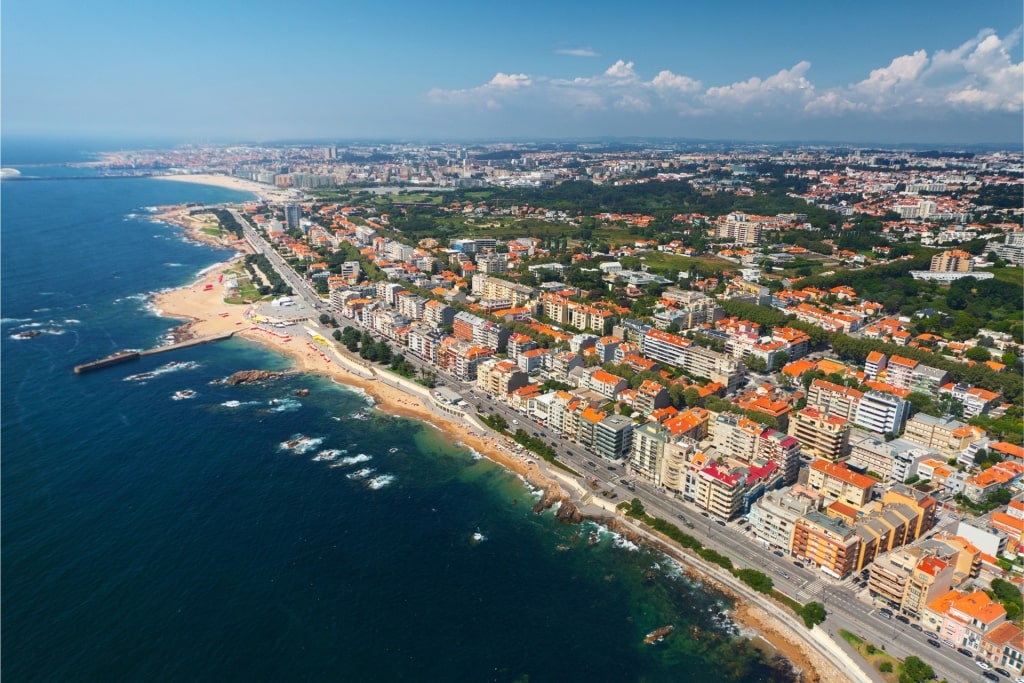
Matosinhos
Matosinhos is the nearest nice beach town to Porto and can be reached by metro. However, the prettiest beach towns near Porto are located further south, including Costa Nova in Aveiro.
Are there any beach towns with golden sand in Madeira?
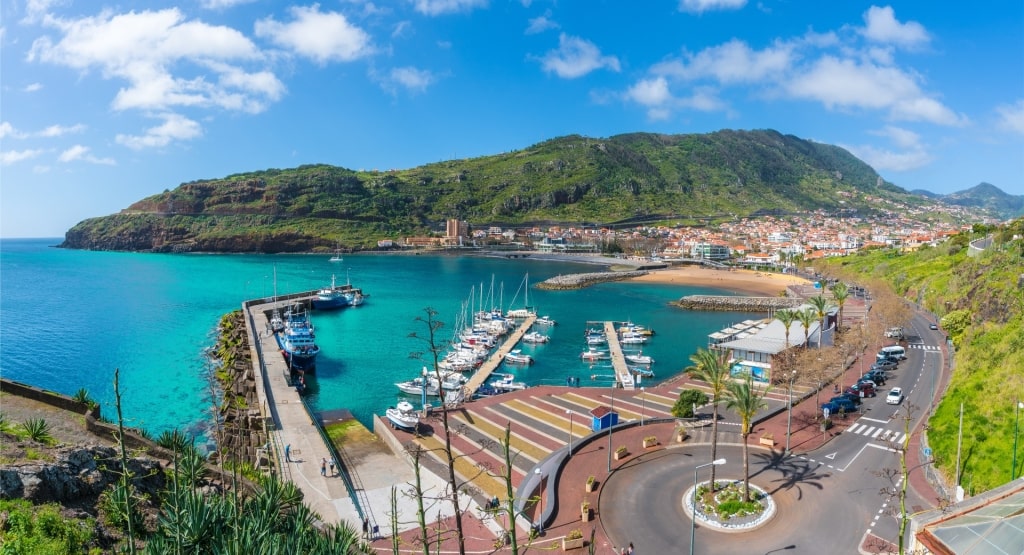
Machico
Most beaches in Madeira are volcanic. For more typical golden sands, head to Calheta or Machico, two beach towns where the shores are lighter due to imported white sand.
Are there lifeguards at Portugal’s best beach towns?
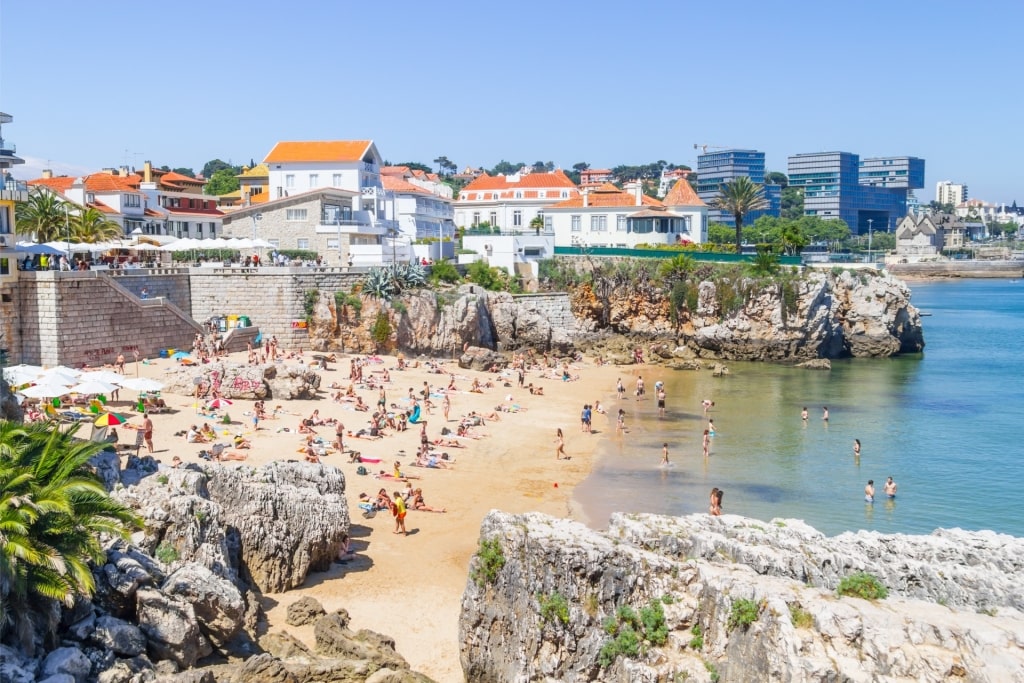
Cascais
Most of Portugal’s beach towns have lifeguards during the main bathing season, which runs from June until September. Some popular resorts and surfing beach towns are guarded outside of these months—red and yellow flags indicate when lifeguards are on duty.
Which Portuguese beach towns have the best seafood?

Sardinhas Assadas
You’ll find quality seafood and fresh fish at nearly every beach town in Portugal. Matosinhos, near Porto, and Sesimbra, near Lisbon, are two of the finest destinations to enjoy the freshest catch.
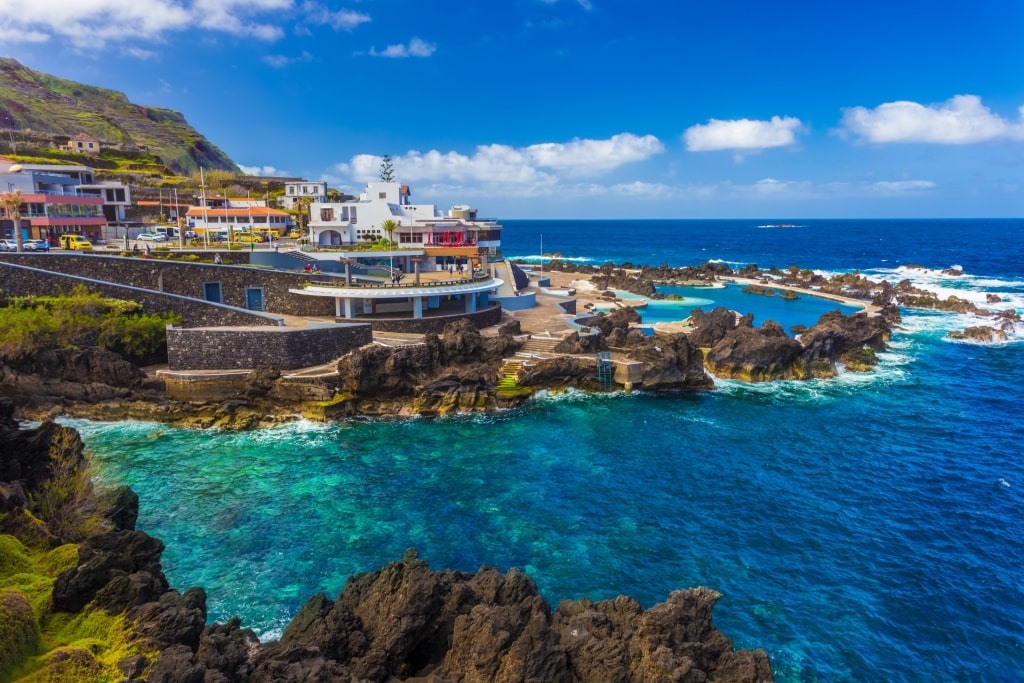
Porto Moniz
Ready to heed the call of Portugal’s coastal hideaways? Browse Celebrity’s Portugal cruises to find your next dream vacation.
